Number 87
June–August 2009
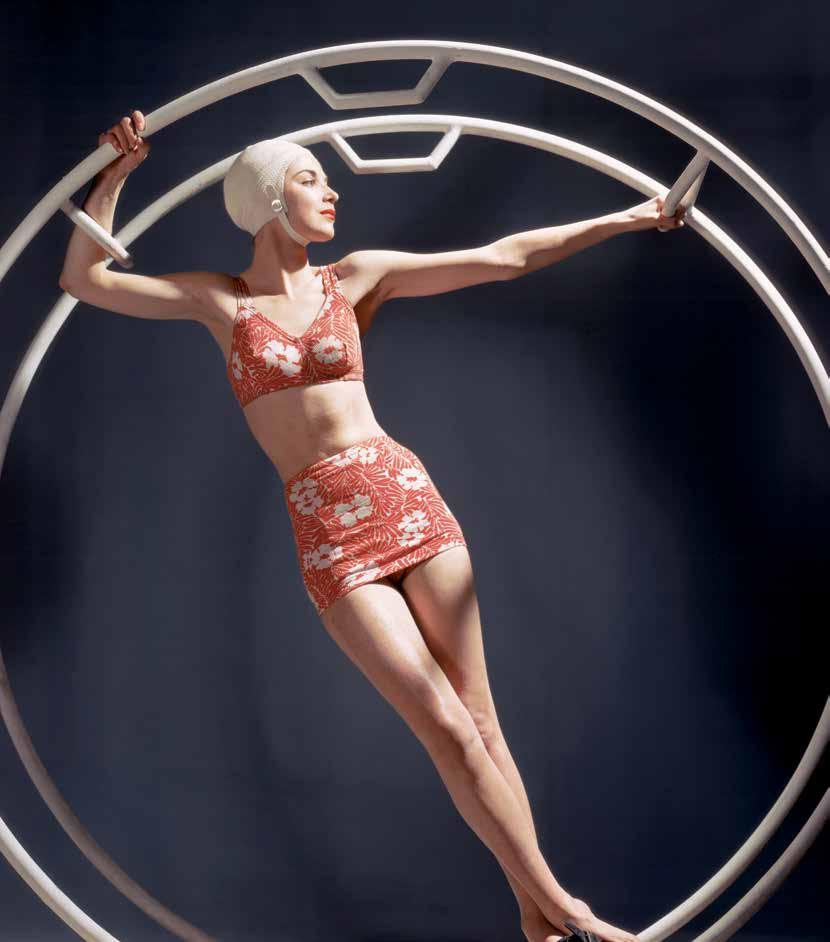

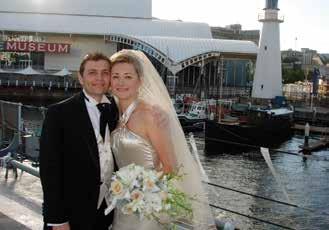
The museum’s unique venues, sweeping city skyline, water views and fine catering will make your wedding day one to remember!
Drinks on destroyer Vampire … dinner for 150 in the elegant Terrace Room ... harbourside Yots Café … or up to 300 in our North Wharf marquee (mid-November to mid-December).
Award-winning Bayleaf Catering is renowned for innovation, quality menus and fine service delivery. A special place

02 9298 3649 email venues@anmm.gov.au www.anmm.gov.au/venues

to tie the knot
Signals
Australian National Maritime Museum’s quarterly magazine Number 87 June–August 2009

COVER:
Model in an exercise ring wearing a two-piece Jantzen swimsuit photographed by John Rawlings for Glamour magazine, 1946. Reproduced courtesy Condé Nast. This image is from Exposed! The story of swimwear, an Australian National Maritime Museum travelling exhibition opening here on 2 July.
ABOVE:
Anthony Field, the Blue Wiggle (front row, centre) appeared with Australian National Maritime Museum volunteers and director Mary-Louise Williams (centre rear) at the launch of National Career Development Week at the museum on 12 March 2009. Photographer Merinda Campbell/ANMM.
Contents
2 Exposed! The story of swimwear
Sirens, stars, bathing beauties, athletes, swimmers and designers
10 Woollen Mermaids
Curators collaborate with fashion creators
14 The last RoRos
Spectacular photographs record the end of a shipping era
18 A champion of the world?
Australian Richard Green in his scull Star of Australia
21 Message to Members, events and activities
Talks, tours, previews, cruises, seminars … winter calendar for Members
26 What’s on at the museum
Winter exhibitions, events and activities for visitors, school programs
30 Banks’ Florilegium
Our travelling exhibition shares these lovely artworks with Australia
36 HMAS Vampire – looking good at 50 Commissioned 50 years ago; meet Vampire veteran Len Price
40 The Mermaid report card
High-school students dive with our maritime archaeologists
42 Tales from the Welcome Wall
From revolution to reunion – Hungarian Gábor Attila Major
44 Off-watch reading
Darling Harbour history; the Daring class destroyers; Charles Darwin
46 Currents & Sponsors
Bulletin artist uncovered; Deckster; Bequests
48 From the director
Page 1 SIGNALS 87 June–August 2009
Movie sirens, aquatic stars, bathing beauties, athletes, swimmers and designers have all played their part in the evolution of the modern swimsuit. All will appear in this Ausralian National Maritime Museum travelling exhibition. Senior curator Daina Fletcher weaves together some threads of history and navigates some dangerous curves.
SWIMWEAR, particularly women’s swimwear, affords us a fascinating glimpse into the complexity of the human psyche and our own society. Its history encompasses topics as diverse as identity, feminism, flesh and femininity. It is a story in which Australia has played an important role, for within the threads of its history we have both styled and shocked the world.
The beach-girl and the bronzed Aussie have been a part of our national identity and the image we project to the world since the early 20th century, evidenced by the new exhibition’s profusion of tourism posters. More than that, however, swimwear has always been associated with sex and sexuality, culture and controversy, making front-page news, filling front-row seats in sporting
At the beginning of the 21st century, why have an exhibition on the history of swimwear? What more can be said about it? Well, we thought first to promote the Australian National Maritime Museum’s diverse collection of historic swimwear and, secondly, to probe the story a little further. What was the Australian contribution to swimwear? How did Australian swimmers and swimwear designers shape the history of the bathing costume?
The museum has been assembling its swimwear collection since curators were first appointed to develop our national collection in 1986. Some people questioned that, originally … what was a maritime museum doing, collecting cossies? Today, we see the benefit. There are now more than 450 items of historic swimwear, making ours one of the richest holdings in Australia. It was developed to illustrate types and designs of costumes, items from swimming champions, as well as swimming memorabilia, related apparel such as sunglasses, bags, umbrellas and parasols, and both archives and advertising from swimwear companies and designers. The collection continues to grow, with both historic and contemporary items being added.
stadiums, popularising styles and creating role models in the film, fashion and swimwear world.
As recently as last year’s Beijing Olympic Games, swimwear was making headlines around the world. Speedo’s LZR Racer suit, which features in the exhibition, attracted many critics who said that it gave athletes an unfair advantage, likening it to performance-enhancing drugs. Swimmers gushed that it turned them into faster, more-efficient missiles. American champion Michael Phelps, then under a sponsorship contract with Speedo, said: ‘It does give you that extra tenth or hundredth [of a second] that you need to break a record.’ Meanwhile its manufacturer boasted about the depth of research that lay behind it, citing NASA and leading software firms as contributors.
Speedo claimed the full-body LZR racing suit was a major technological leap in drag reduction. It had no seams; its three parts were welded, not sewn, together. It compressed the swimmer’s core muscles, rather like a girdle, creating a sleeker body line. After much controversy, the world governing authority for swimming, FINA,
SIGNALS 87 June–August 2009 Page 2

Rudi Gernreich’s futuristic bare-breasted ‘monokini’ caused a gigantic intake of breath all over the world
Peggy Moffitt modelling Rudi Gernreich’s topless swimsuit 1964. Photograph by William Claxton/Courtesy Demont Photo Management (www.demontphoto.com)
Page 3 SIGNALS 87 June–August 2009
Drowning in wool
In the Victorian era bathing in the sea and indoor baths – if it happened at all – largely meant lolling in the water for medicinal benefits: to regulate action of the bowels, to ease muscle disorders, sprains, headaches and neuralgia. The associated swimwear created its own health hazards.
The English publication Cassell’s Household Guide (London, 1880s) wrote of the ‘… great reform [that] was needed if utility, health, and comfort were to be preserved. The long, loose gown formerly worn was apt to cling to the bather as she left the
water and cause a chill, and swimming in such a garment was almost impossible. Even in dipping in and out of the water, it would cling around the legs and impede freedom of motion.’ The writer continued ‘There is no reason why bathing garments should not be prettily ornamented; but by ladies of good taste, what is remarkable will be decidedly avoided.’
The Guide published a pattern for just such a suit. It needed close to five metres of serge, with weights sewn into the hemlines of the tunic to prevent it from floating up.
‘When a woman enters the water clad in Madam Grundy’s conventional wardrobe, she invites troubles galore’
approved the swimsuits in April this year. Their conclusions: ‘There is no scientific proof that it helps,’ and ‘Other companies are due to come out with [competing] suits’.
In terms of controversy there was little change from a century earlier … when headlines also centred around a full body suit! In the early 1900s, when most women were wearing voluminous and restrictive swimwear, Australian swimming star Annette Kellerman made the front-pages by championing a modern new look, both for the swimsuit and for women too. This period brought a new androgyny to the swimsuit as men and women were gradually allowed to wear the same designs.
The problem, as Kellerman would later reflect in her 1918 book How to Swim, was that ‘... when a woman enters the water clad in Madam Grundy’s conventional wardrobe, she invites troubles galore ... There is no more reason why you should wear those awful water overcoats … than there is that you should wear lead chains. Heavy bathing suits have caused more deaths by drowning than cramps.’ (See accompanying box Drowning in wool.)
Kellerman was referring to the tunic with pantaloon-style bathing dress, a costume that failed to meet the needs of the growing numbers engaging in the sport as swimming and surf bathing gained popularity. Dubbed ‘Australia’s mermaid’ and ‘the perfect woman’, Sydney-born Kellerman was Australia’s 100-yard champion when she sailed for England in 1905 to seek fame. In its pursuit she swam the soupy Thames, parts of the English coastline, the River Seine and even attempted the English Channel three times.
Her performance of swimming and diving tricks attracted a royal audience and led to a development of her costume when, under directions from London’s Bath Club before her performance for the Duke and Duchesse of Connaught, she sewed tights onto the man’s swimming suit that she normally wore. Kellerman’s famous full-body suit was born.
Lured by vaudeville in America, she became a sensation performing aquatic feats in tanks, diving in her head-to-toe woollen costume, much like a full body stocking, and doing water ballet in a range of provocative, colourful and – for the time – titillating costumes and exercise suits. In 1907 it’s said that


she provoked arrest in Boston for daring to wear a man’s swimsuit in public, exposing her legs on the beach, although she wasn’t convicted.
Kellerman was a leading advocate of health and exercise for women and, with it, functional swimwear. She created a brand of her own that she could market.
‘Social rather than natatorial purpose may be all very well to conform to the fashions of the beach and wear a dashing petticoat with slippers, cap and cape to match,’ she wrote. ‘But where swimming is engaged in as a genuine sport and not as a mere excuse for social diversion, the very best society permits and approves of the close fitting swimming tights, or of the twopiece suits commonly worn by men.’
Here Kellerman enunciated well the dual direction that swimwear design was to follow, the functional and fashionable imperatives playing out in their various spheres as the 20th century progressed. Kellerman’s writing helps us tease out influences on Australia’s contribution to swimwear history – and her costumes will be on show in Exposed!, one of her own brand from the ANMM collection, along with her diving, exercise and performance suits on loan from Sydney’s Powerhouse Museum.
SIGNALS 87 June–August 2009 Page 4


Swimwear evolved into both a sporting garment and a fashion item after World War I, led by nations such as the USA, Britain and Australia. Women’s swimwear in particular became briefer and briefer. Backless suits for women and topless suits for men dominated the 1930s.
In 1946 French designer Louis Réard came up with a costume so explosive that he named it after the Pacific atoll Bikini where the Americans were testing their nuclear bombs. In the 1950s French actor Brigitte Bardot became the primordial bikini girl, a sex kitten who also paved the way for the more dangerous Bond girls of the sixties – the image of Ursula Andress in bikini with knife belted to her hip becoming one of the most memorable screen icons of the 20th century.
In the 1960s too, Hollywood beach movies starring screen and singing idols Elvis Presley, Annette Funicello, Frankie Avalon and Sandra Dee saw the swimsuit somewhat sanitised as a symbol of freedom and uninhibited fun for the youth of the day. They became role models for a generation of young Australians. All owed a huge debt to Annette Kellerman, the original screen mermaid, whose exploits on film had redefined

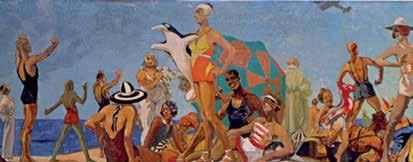

ABOVE FROM TOP:
Advertising flyer for Jantzen men’s swimwear, 1930s.
ANMM collection
Detail from Bondi beach scene 1934 by D H Souter, oil on masonite. Lent by Bondi Surf Bathers Life Saving Club
Movie poster for Million Dollar Mermaid, Hollywood’s tribute to the life of Annette Kellerman. Image: Corbis
OPPOSITE: Australian professional swimmer, vaudeville and film star Annette Kellerman, in her full-length swimsuit c 1900–1910. Image courtesy United States Library of Congress.
Page 5 SIGNALS 87 June–August 2009
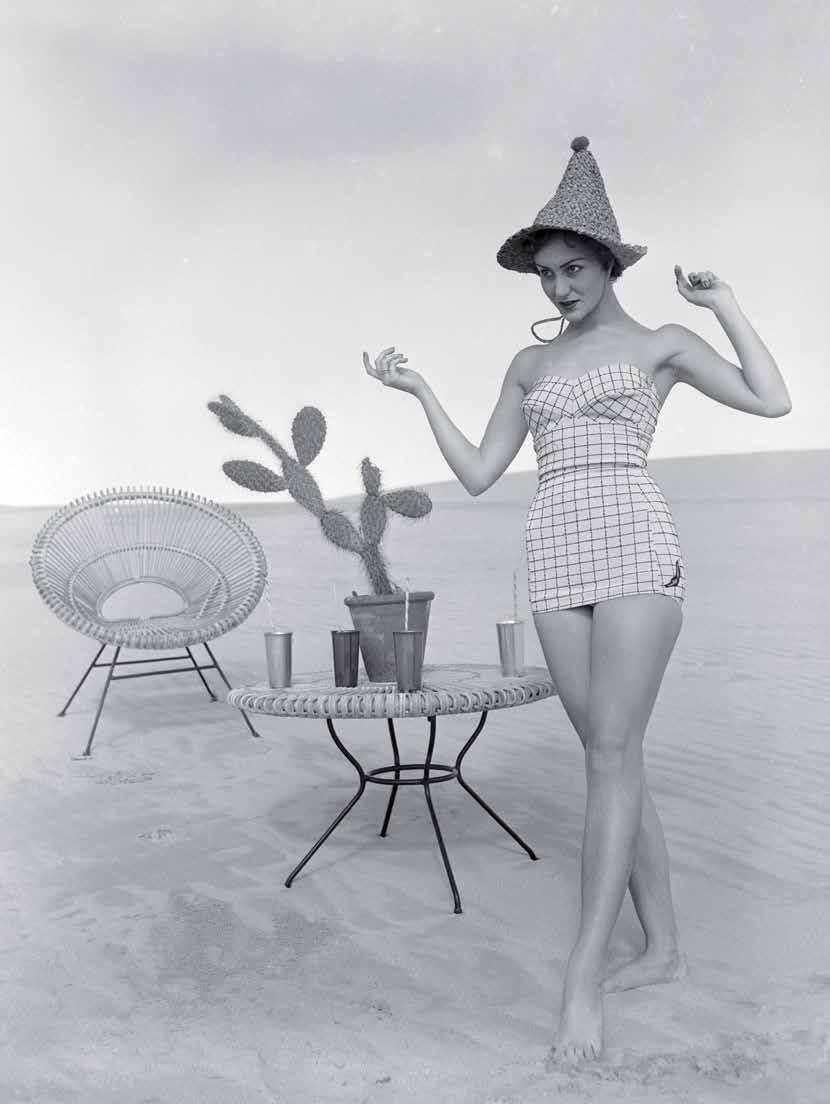
SIGNALS 87 June–August 2009 Page 6
RIGHT: Magazine of 12 May 1934 contains designs for knitting woollen swimming costume illustrated on the
FAR RIGHT: Sheet music for Janzten Australia’s jingle ‘There’s nothing like a Jantzen in the world’. It was used in a 1951 advertisement for Nylastic swimsuits. ANMM collection
OPPOSITE AND BELOW: Swimwear fashion photographs by Gervaise Purcell, 1950s. Reproduced courtesy Leigh Purcell

attitudes towards the swimsuit and the display of women’s bodies from the early 1900s.
Then in 1964 Rudi Gernreich unveiled his futuristic bare-breasted bathing suit called the ‘monokini’, which caused a gigantic intake of breath all over the world. The Vatican denounced this topless swimsuit, but an unrepentant Gernreich sold more than 3,000 in less than a season in Europe. Defending his creation, he said, ‘Sex is in the person, not in what she puts on.’ In the more puritanical USA, however, monokinis were mostly discounted for a few dollars at the end of the season. In actual fact, the display of breasts was illegal on most public beaches around the world.
Gernreich continued with his body-baring designs by introducing his thong bathing suit in 1974. This was followed by Rio and St. Tropez, introducing the ‘Tanga’ suit, or Brazilian Thong, which required ‘not only the dental flossing of one’s buttocks but a derriere without a trace of cellulite and nerves of steel!’
Our exhibition features a monokini on loan from the National Gallery of Victoria, in a section on defining global swimwear moments. We also question how Australian designers responded


Swimwear has always been associated with sex and sexuality, culture and controversy, making front-page news
to their environment, to the strong Australian swimming culture and to these international trends in swimwear fashion.
Australia, most famous through much of the 20th century for its wool industry, developed a swimwear design and manufacturing industry in tandem with a developing knitwear manufacturing base. International companies such as the American Jantzen made swimwear here to meet local demand, while Speedo was created in 1928 by MacRae knitting mills (founded in 1914). Speedo launched its first range with an innovative racer-back shoulder strap, an important breakthrough in competitive swimwear design. The company’s growth paralleled the rise of Australian swimming champions through the 20th century, from Andrew ‘Boy’ Charlton through the golden midcentury generation of legendary swimmers such as Dawn Fraser, Murray Rose or Lorraine Crapp. Speedo became a giant, cornering the Olympic market from its American rival Jantzen. Both specialised in athletic swimwear which distinguished them from other more fashion-driven labels.
Australia was quick to embrace innovation, absorbing influences while creating its own styles. Melbourne brands
like Black Lance produced high-quality garments for the local market in both athletic and fashion designs. Paula Stafford from Queensland’s Gold Coast picked up on the two-piece bikini very quickly after its European launch. There were many other major new ideas to come – separates, boardshorts and surfwear among them – including the Mambo and Ripcurl brands. Aheda Zanetti’s recent Burquini designs – aimed at reconciling Australian beach and Muslim cultures – have been exported to the Middle East.
Swimwear development was driven by textile technology just as much as by societal attitudes, fashion and sporting aspirations. Since the 1880s changes in textile technology have influenced design, performance and appeal in the quest for lighter, more elastic, drier swimsuits. The move from serge, a woven wool fabric, to knitted silks and cottons used for the androgynous Canadian-style suit and then to knitted wool, occurred in the first two decades of the 20th century as swimmers appealed for more figurehugging suits.
Wool was then the most elastic fabric available. The rib knit gave woollen swimsuits their stretch: vertical ribs
cover. ANMM collection
Page 7 SIGNALS 87 June–August 2009
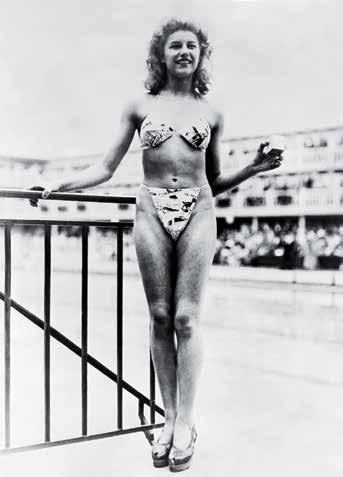
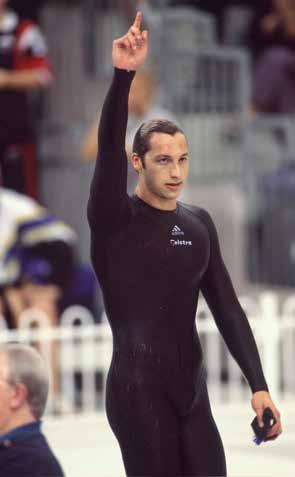
provided strength and the horizontal weave yielded stretch. First used for men’s rowing suits, the tight rib knit was adopted for the torso-hugging male swimsuit and then the female one-piece.
Silk was used at this time for racing swimsuits because it is light, with a tight weave when dry. Kellerman wore them, while Sarah ‘Fanny’ Durack and Mina Wylie – Australia’s first two female swimmers at the Stockholm Olympics of 1912 – wore them in competition. Silk suits were also extremely fast drying but, like wool, they were saggy when wet, and quite expensive.
Swimwear companies introduced Lastex, a form of rubber interwoven with fibre, which reduced sag, resulting in a more figure-hugging and flattering garment. Adopted in Australia in the 1930s, Lastex styling quickly became associated with the decade’s new, suntanned, glamorous, leisure-and-sporting ethos.
Rayon and other synthetics were introduced in the 1930s as affordable alternatives. The first products made of Nylon – stockings – were introduced in 1939, followed by swimsuits in the 1940s. Nylon swimsuits absorbed little water, dried quickly, were elastic,
and were colour-fast. It made strapless swimsuits possible and made a competitive racing suit.
The next big advance was Lycra, created by DuPont in 1958. It is significantly stronger than Nylon with both vertical and horizontal stretch. Today, Lycra refers to a variety of highly elasticised synthetic fabrics which can sculpt and streamline the body. The biggest technological leap is recent years is of course that of the LZR racer, on a design that has in one sense come full circle back to Annette Kellerman’s full-body suit a century before … although Speedo, the company that created the LZR, was by this time foreign owned.
In a nod to the past and an imaginative leap into the future the Exposed! exhibition plays with contemporary textile technology and ideas about swimwear in the finale to the show. A segment called Woollen mermaids features suits by both emerging and established swimwear designers who are also represented by a selection from their collections. (See article on the following pages.) Designers have been invited to design and make a one-piece women’s swimsuit in stretchy, all-black wool Lycra – again harking back to the era of Annette
Kellerman. The results are exciting, edgy and provocative, much like Kellerman was herself.
Exposed! The story of swimwear is here until 25 October 2009. This is an Australian National Maritime Museum travelling exhibition supported by Visions of Australia, an Australian Government program that assists the development and touring of cultural material across Australia. The exhibition will visit Perth, Adelaide, Brisbane, Wagga and Newcastle in 2009–2011.

The author of this essay, Daina Fletcher, senior curator maritime communities, offers special thanks to co-curator Penny Cuthbert (ANMM) and fashion and concept consultant Dr Christine Schmidt, Queensland University of Technology.
ABOVE LEFT: Exotic dancer Micheline Bernardini models the world’s first bikini, designed by Louis Réard 1946. Image: Corbis
ABOVE: Swimwear enters the 21st century: Ian Thorpe during Sydney 2000 Olympics swim trials. Image: Corbis
SIGNALS 87 June–August 2009 Page 8


*Valid until 30 September 2009. Subject to availability and conditions apply. Based on twin share accommodation. THE SPECIAL ESCAPE H o LI d A y IS b AC k by P o P u LA r d E m A nd. At Novotel Rockford Darling Harbour you can relax and unwind in one of our Superior King Rooms and enjoy FrEE full buffet breakfast. We are at the heart of vibrant Darling Harbour and conveniently located near... well... everything. reservations 1800 606 761 darlingharbour@rockfordhotels.com.au Proud supporter of the Australian National Maritime Museum $189* per room inc breakfast from Designed for natural living www.rockfordhotels.com.au Page 9 SIGNALS 87 June–August 2009
Woollen Mermaids
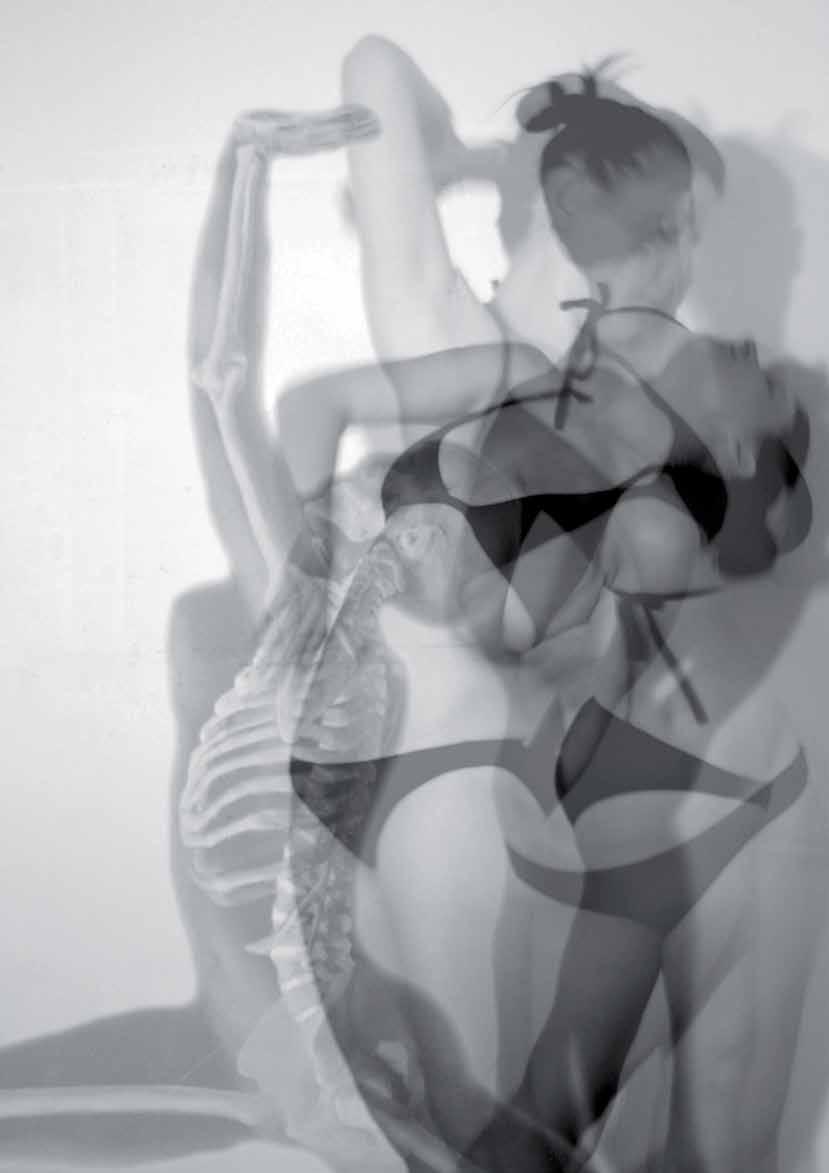
Research into the anatomical structure of the body underpins this design student’s creative approach to the Woollen Mermaids project. Design by Vanessa Flynn, Queensland University of Technology. All QUT student artwork is reproduced courtesy of the artists.
SIGNALS 87 June–August 2009 Page 10
Exhibition consultant Christine Schmidt writes of a collaboration between the museum, Queensland University of Technology and contemporary fashion designers that highlights the swimsuit as an iconic component of Australian style, and threads together the past, present and future of swimwear.

OVER THE LAST four years I have zipped myself into a PhD research project that focused on the evolution of the modern swimsuit. In particular it traced how a peripheral nation, Australia, has influenced the design direction of the swimsuit in the 20th century and beyond, to create a distinctly Australian niche in global fashion. I must admit that previously I had little knowledge or interest in swimsuit design, and had always pigeonholed the swimsuit as a non-fashion garment – at best a glamour item for hot bodies, but equally a focus for personal angst at the beginning of every summer.
The starting point of my work was Annette Kellerman, a mostly forgotten Australian swimmer, diver, vaudeville
through to a new breed of contemporary swimsuit designers who tap into fashion trends while maintaining an Australian handwriting, exemplified by the Zimmermann and Tigerlily fashion labels.
To understand the shape and direction that swimwear has taken required an archival research for artefacts. This was an opportunity to connect with tangible evidence from the swimsuit’s formative years – a visual and tactile narrative. Preliminary visits to Sydney’s Powerhouse Museum and Manly Art Gallery and Museum unearthed a number of historic and contemporary swimwear artefacts, both local and imported, that included a significant collection of Annette Kellerman’s performance and vaudeville costumes.
Woollen Mermaids is a concept that ambitiously aims to thread together the past, the present and the future
performer, and silent movie actress. She achieved success across a number of related fields – in fashion, film, sport, and as a role-model for women, encouraging self-motivation and self-development. Kellerman won global fame and recognition for popularising the one-piece swimsuit, and for her innovations as an aquatic performer and as a fitness writer. (For more on Kellerman, see Daina Fletcher’s article on the previous pages.)
Australia has continued to be associated with the values championed by Kellerman, and has become a launching pad for a number of international swimwear and surfwear companies. These range from iconic brands like Speedo, Quiksilver and Billabong,
However, it was the Australian National Maritime Museum that proved to have the most extensive collection of swimwear from the early 1900s to the present. I was surprised to find that a museum so closely associated with big ships and seafaring accoutrements was also a rich source of artefacts related to beach and leisure pursuits. Indeed, the museum has permanent beach and surf culture displays, and has exhibited a selection of Kellerman and other swimwear. Yet to date there has not been an exhibition focusing exclusively on swimwear.
From 2005 my PhD research involved me in discussions with ANMM curators Daina Fletcher and Penny Cuthbert, who had also been researching the swimsuit.
An outcome of this is a collaboration on Australia’s first major swimsuit exhibition, Exposed! The story of swimwear opening in July 2009 at the museum. As part of my role as a fashion and concept consultant for this exhibition I have been involved in creating a subtheme called Woollen Mermaids, which will feature designs created by Australia’s foremost contemporary and new generation designers. Most museum exhibitions look to the past. Ours is a concept that ambitiously aims to thread together the past, the present and the future. Including this contemporary fashion sub-theme both enlivens the museum experience for visitors and contextualises where we have been with where we are now.
We invited a number of key Australian designers, including Zimmermann, Jets, Seafolly and Watersun, to reinterpret the one-piece bathing suit for the 21st century. Inspired by the original ‘mermaid’, Annette Kellerman, we briefed them to use a technologically advanced wool-Lycra mix in classic black – a reference to early swimsuits that were primarily made in wool. Like Chanel’s ‘Little Black Dress’, the black swimsuit underpins a minimalist aesthetic that requires an exceptional cut, clever trims and flawless construction. It has been an opportunity for designers to dazzle with their creativity and virtuosity –to craft a swimsuit that reflects both their signature style and the design inspiration for this brief. It is about invention and reinvention.
While we were waiting for the swimsuits, I pondered the possibility that the designers might have been overly constrained by our brief of monochromatic black and a one-piece style.
Page 11 SIGNALS 87 June–August 2009
What ideas, treatments and cuts would define and individualise the swimsuits? I needn’t have been concerned. The results were spectacular and serendipitous; their whimsy, beauty and diversity revealed why Australia has a global reputation for producing high-quality swimwear.
Figure 1 illustrates the different approaches of four designers. Tigerlily has created a glamorous and theatrical effect. A dramatic contrast is achieved through the cut-away side sections that draw the eye to the entwined body
A swimsuit is a swimsuit is a swimsuit
It then remained to look to the future and budding designers, with the inclusion of Queensland University of Technology second-year fashion students. They were invited to design swimsuits based on the same Woollen Mermaids brief, using the same wool-Lycra textile. The project gave the students a chance to see to how their designs measured up against the creations of Australia’s leading fashion and swimwear designers.
Their whimsy, beauty and diversity revealed why Australia has a global reputation for producing high-quality swimwear
beneath the cascading, glittering beads. Anna & Boy’s swimsuit is reminiscent of a Victorian corset in styling with subtle textural details such as laser-cut trims creating a lacey, feminine effect. By contrast, the Zimmermann swimsuit is minimalist, devoid of trims – sharp, clean and geometric. The lattice-like cut-outs create effective peepholes to the body. Jets Black Label swimsuit makes a statement through a central panel on the swimsuit and armbands encrusted with black bugle beads.
The Woollen Mermaids swimsuits reflect nine of Australia’s contemporary designers’ personal vision and interpretation of the design brief, highlighting an expertise and vibrancy in a highly specialised segment of the fashion market.
A core intention of our Woollen Mermaids sub-theme was to make the design process visible and to a give a voice to fashion from the designer’s perspective. Consequently the contributing QUT students were asked to create an online record of their work – a blog – that tracked the process from design inception through to the final garment. This allowed the students to articulate their personal swimsuit design journeys, and the public to learn first-hand how this unfolds. It’s linked to the ANMM website, and can be viewed at http://thestoryofswimwear. wordpress.com
The swimsuit was unknown territory for the students. Before starting this project I had delivered them a lecture on the history of the swimsuit and its importance to the Australian fashion industry.
During question time, one student asked if they would only be making swimwear, or would the course unit include opportunities to produce fashion garments? Here again was the perception that the swimsuit is not part of the fashion landscape. An early blog entry by Anna entitled A New Dark Age illustrates the way many of them at first approached the project:
And in the beginning there was… NOTHING! Absolutely nothing. Been given this brief my initial thoughts lacked excitement. Swimwear!?
However, as Anna worked through the process, anchoring ideas through historical and contemporary research to create a design focus, her final comment in this entry reflected a general student trend upon diving into our project: I knew we could all find a way to make swimwear interesting!!!
The challenge for the 29 students was to navigate preconceived ideas about swimsuit design and learn new patternmaking and production techniques to design and produce an innovative and spectacular swimsuit. First-year Design Studio in the QUT Bachelor of Fine Arts degree involves introductory design, patternmaking and production techniques, primarily for woven textiles, with an emphasis on tailoring and structured garments. This project introduced new skills, in particular how to work with stretch fabrics, to design and construct swimsuits that fit the body like a second skin.
Unlike woven textiles that lack flexibility, a jersey knit can produce extensive and

SIGNALS 87 June–August 2009 Page 12
Photograph by Michael Armstrong.
RIGHT: Figure 2: An inflatable swim vest is first deconstructed in this student’s exploration of the sobering intersection between fashion and global warming.
BELOW: Figure 3: A student’s working drawings show how creative design evolves.
dynamic variations. Knits are ‘forgiving’. If the pattern pieces do not align exactly, they can be stretched and manipulated to achieve the desired fit. Of course once a student finalised the design, the pattern pieces were accurately traced and notched to ensure that further swimsuits produced from this original pattern would fit perfectly. Because swimsuits can be stitched up relatively quickly, it gave the students more time to experiment and play with the fabric, and to create diverse and at times quirky designs.
Angela H created a dramatic narrative about the future mermaid battling a ‘flooding universe’ as a result of global warming. Using an inflatable swim vest as the inspirational starting point, a number of patterns were developed
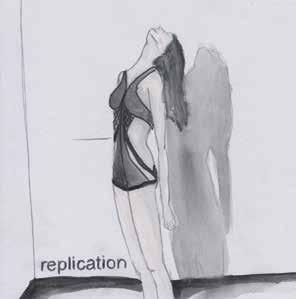

that in turn led her back to the existing inflatables. Through such experimentation, the originals proved the most effective foundation block for the design rather than trying to create new shapes. However, it was not just a case of covering the vest with fabric. How would these pieces work with the wool-Lycra to create a swimsuit?
(See Figure 2.) To follow the progress of Angela H or other students, click on their name in the student column to the right of the front page of the blog.
The body of work documented by the QUT students represents an informative window into the design process – how a designer formulates, tests and prototypes a design. For some the focus was the textile: twisting, pleating, painting and
folding the fabric to produce sculptural effects. Vanessa’s blog entries provide an insightful glimpse into the thought process behind her designs, taking the reader through the textile experimentation stage combined with research into the anatomical structure of the body, and how this influenced her final design boards (see Figure 3).
The Woollen Mermaids project has produced collaborations between the ANMM, QUT and the fashion industry, generating innovative outcomes that highlight the swimsuit as an iconic part of the Australian style. The contributing designers, both established and emergent, affirmed the swimsuit as fashion through designs that embody an active glamour reminiscent of Annette Kellerman.

 OPPOSITE: Figure 1: Swimwear created as a special commission for the exhibition by designers (LEFT TO RIGHT) Tigerlily, Anna & Boy, Zimmermann and Jets Black Label. The suits were donated for the museum collection.
OPPOSITE: Figure 1: Swimwear created as a special commission for the exhibition by designers (LEFT TO RIGHT) Tigerlily, Anna & Boy, Zimmermann and Jets Black Label. The suits were donated for the museum collection.
Page 13 SIGNALS 87 June–August 2009
To some they were ungainly, to others magnificent – but the Roll-on-Roll-off motor vehicle carriers were the last regular cargo ships to unload in the Port of Sydney. Museum photographer Andrew Frolows documented their final visits for an exhibition now on display, as Sydney Harbour took yet another step away from its working roots.

lastTheRoRos
THE IDEA for the RoRo project came to this museum’s curator of commerce, Patricia Miles, while commuting to work by ferry. Patricia was intrigued by the unusual design of the ‘K’Line Roll-onRoll-off vehicle carriers, fittingly named after highways from all over the world. Knowing that the Glebe Island car terminal where they unloaded was soon to be decommissioned, Patricia realised the need to document one of the last major, industrial, working-harbour activities taking place in the Port of Sydney –the vehicle trade. The giant ships were the last RoRos to bring cargo into Sydney.
Patricia proposed that I photograph the vessels on the water, inside their holds, and as they unloaded the vehicles – and the Glebe Island facility from the air, to capture the size and scale of the operation. It was all made possible by ‘K’Line staff who very kindly arranged access to the ships and the terminal, and funded the helicopter hire.
Our first excursion to Glebe Island terminal was in mid-2007 to scope the project and its technical considerations. We were guided through the Ingolstadt by a ‘K’Line operations officer and I took some test shots to check the lighting, exposure and composition. Due to the
mixed nature of the lighting (daylight, fluorescent, tungsten and sodium vapour) I opted to use auto white balance at 400 ISO using a Canon 5D digital SLR camera with a Canon EF 17–40 mm zoom lens.
I chose this equipment for the onboard and from-the-water photography for its lightness and versatility. The vessels are very large with multiple decks and narrow stairwells, and carrying heavy equipment would have added to the difficulty.
ABOVE: Crew of the ‘K’Line ships had little time in port. On this visit 841 vehicles rolled off in a 12-hour berthing. All photographs by Andrew Frolows/ANMM
OPPOSITE: Glebe Island automotive terminal covered 12 hectares, stored 5,000 vehicles and could berth two ships.
as much detail as possible. The larger format camera was not a problem in the helicopter. Photographing from a helicopter is one of my favourite things to do! With the door off the view is truly spectacular. The beating of the blades, the wind, the superb manoeuvrability, the ability to just hang suspended –it completely focuses the mind on capturing the best image possible. It’s important when photographing
Photographing from a helicopter is one of my favourite things to do – the beating blades, the wind, the ability to just hang suspended
We returned to Glebe Island in September 2007 to photograph the unloading of the cars and take external shots of the Rockies Highway as it left the harbour, and some of the images in the exhibition come from this session. As the large exhibition prints demonstrated, the Canon 5D produced fantastic results.
For the aerial shots, I chose to use my Mamiya 645 AFD medium format camera with 80 mm lens and an Imacon 22 megapixel digital back producing a 63 megabyte file, as I wanted to capture
from a helicopter to use a high shutter speed otherwise you end up with blurry mush from mechanical vibration. To shoot at 1/250th of a second I had to increase the ISO to 200. This combination still enabled me to produce very highresolution images.
Our flight time was dependent on both the light and the vessel sailing schedule. These coincided fortuitously one Monday afternoon. The weather was variable and there were some heavy clouds building and occasionally obscuring the sun,
SIGNALS 87 June–August 2009 Page 14

Page 15 SIGNALS 87 June–August 2009
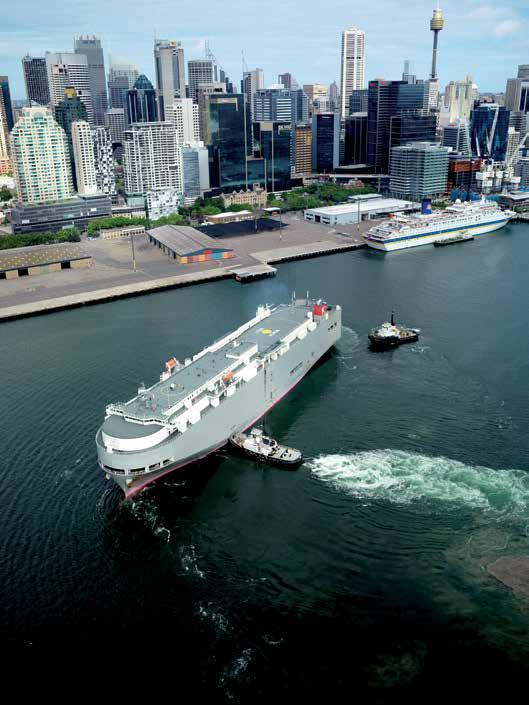
but the Rockies Highway was unloading and the afternoon light could have potential, so up we went. Luckily as we arrived above Glebe Island the clouds parted and the sun broke through, lighting the site with a pleasant late-afternoon cross light. We flew in ever-widening circles around Glebe Island to cover the site from as many angles and varying distances as time would permit.
I only had about 15 minutes of good light to cover the site until the clouds rolled in and the light was gone. I had booked the helicopter for an hour, so I arranged to use the rest of the time another day. On getting back to the studio I was glad to find that I had some good shots of the Glebe Island terminal and didn’t need to go back.
So we decided with the remaining flying time to cover some other aspect of RoRo activity.
Patricia Miles suggested that some shots of the Rockies Highway turning around in Johnstons Bay, as it was towed stern-first from the Glebe Island terminal, could make an interesting image. The opportunity presented itself a month later when the Rockies Highway was back in town, so up we went again to photograph the ship turning. I was really pleased with the shots from this session and I particularly liked the combination of the ship with the CBD as a backdrop. If you look closely the city appears strangely deserted, giving the image an eerie quality.
LEFT: The ship has been tugged stern-first to assist it to turn, before heading into the shipping channel. Behind it the last cargo wharves of Darling Harbour, vacated in November 2007, await transformation into the Barangaroo redevelopment.
TOP RIGHT: Teams of specialist stevedores made short work of emptying the ocean-going giants.
RIGHT: Lined up in a complex logistical operation, vehicles await removal by car transports.
Taking the images is only half the task. Subsequently quite a bit of time is spent editing, photo-shopping, making a final image selection, digitally up-scaling the final exhibition image selection, printing, framing and finally hanging.
Photographing the RoRo project was a most enjoyable assignment and I hope that in a small way my photographs give an insight into the day-to-day working life of the curious RoRo vehicle carriers which once passed within sight of this museum but now, as far as Sydney Harbour is concerned, have sailed into history.
The photographic exhibition The last RoRos into the Port of Sydney is in the Tasman Light gallery until 28 June 2009.
SIGNALS 87 June–August 2009 Page 16
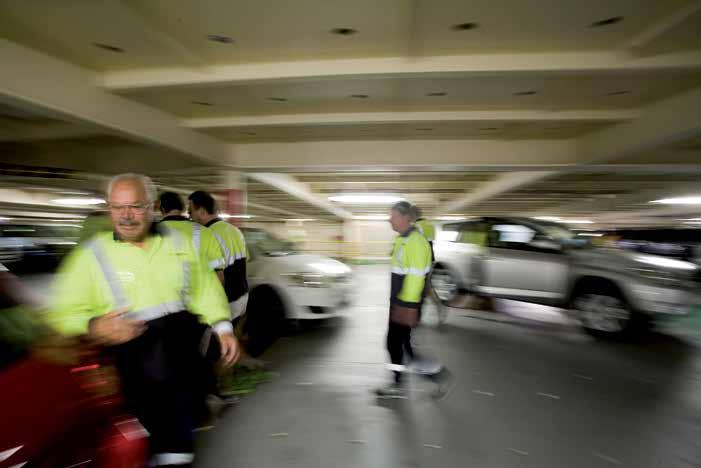

Page 17 SIGNALS 87 June–August 2009

A champion of the world?
Research by curator of the museum’s Australian Register of Historic Vessels, David Payne, has pieced together the fascinating story behind this 1863 lithograph, donated to the museum by a descendant of the champion rower.
A NEW ADDITION to our exhibition
Watermarks – Adventure Sport Play is this lithograph from England, now almost 150 years old. Carefully restored by ANMM conservator Caroline Whitley, it depicts Australian rower Richard Green in his scull Star of Australia on London’s Thames River in 1863. In the background along the crowded Putney shoreline is the London Rowing Club, Bells Tavern and the Star and Garter. The lithograph is one of the last of its genre; other media including photography soon took over the lithographer’s role in capturing historical figures for posterity.
The scull is dramatically poised, angled diagonally across the scene as Green is about to begin a powerful stroke. He is part of the way through a training session on the Thames, but that moment in time from 1863 is also part of the way through a significant story of Australian boatbuilding, sculling and sporting traditions that span many generations. Earlier this year, through the museum’s Australian Register of Historic Vessels (ARHV), we hosted a small gathering of current Green descendants and family members who came to view the lithograph, and to meet each other.
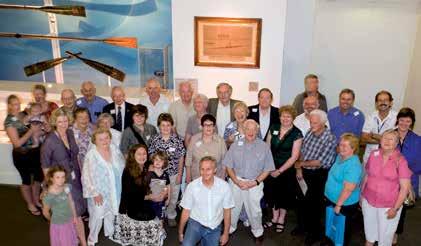
The museum’s first link to this farranging story was Star of Australia itself, built by Richard’s brother Henry at the Greens’ Milsons Point shed in Sydney. Only a shade older than the lithograph, the unique scull survives in the UK. Green family descendant Richard Chapman brought it to our attention and soon Star of Australia was listed on ARHV. The craft’s intriguing tubular shape and the sculler Richard Green were both fascinating subjects, and with research into them the story quickly grew.
Richard Green was born on 23 August 1836 at Greenwich in Sydney. He and his brother Henry were well-known scullers and rowers in Sydney during the 1850–60s, dominating many events on the harbour and Parramatta river in craft they built themselves. Some carried the name Star of Australia. Richard rowed wager races, where backers put up a purse that was then matched by the challenger, and the outcome was open to betting. Richard defeated a number of challengers including the champion English scullers Dewart and Candish who had settled in Sydney. This success suggested Green was up to world standard, and in 1859 a challenge was issued on his behalf to the best from England (or anywhere) to race Green in Sydney. There were
SIGNALS 87 June–August 2009 Page 18
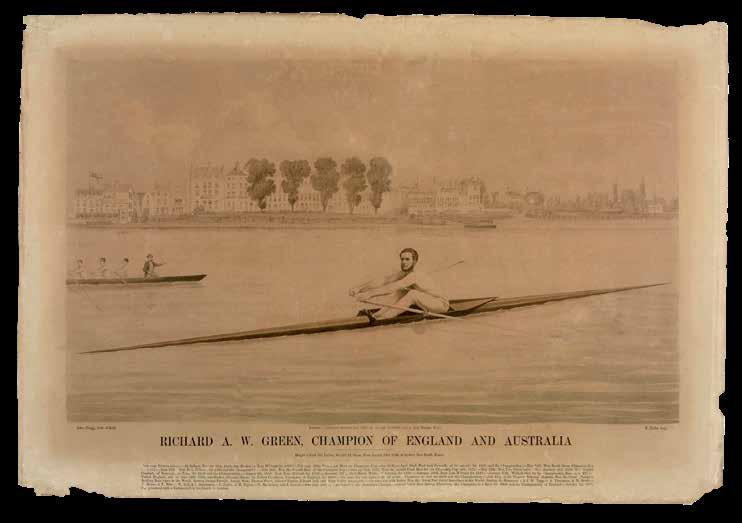
no takers, however, so Green decided to go to London himself, leaving in April 1862 with no apparent backers.
At this time the premier event was the Championship of the Thames, a title held in 1862 by Robert Chambers from Newcastle-on-Tyne. Controversy surrounded Chambers, as he had demanded that challengers meet him on the Tyne, something the organising Thames Subscription Club would not hear of. In April 1863 Green and Chambers agreed to race on the Thames, and tried to bill their match as ‘The Championship of the World’. Again the officials objected and it remained the Championship of the Thames, to be held on 16 June from Putney to Mortlake.
Green trained under the tutelage of a former Thames Champion, Henry Kelley, and stayed at his hotel, the Bells Tavern. Research shows Green was using Star
of Australia while training in the spring of 1863, and the radical shape of the craft was attracting attention. In one report it was ‘considered the best boat in England’, and two other English builders had tried to copy the design. The 10.22-metre-long craft is completely circular in cross section, except where the cockpit cuts into the deck. It tapers gradually and identically to a fine point at the bow and stern – almost two cones joined at midships. Exactly what the theory behind this shape was remains a mystery, but it is known that Henry Green and his father George had examined the idea of tubular craft in other types as they had also designed a lifeboat along what they called the ‘elliptic tubular principal’.
Despite the media suggesting it was the most advanced craft of its type, at some point close the race date Green discarded Star of Australia. It has been said that it was considered too light for the conditions. Judging by its curious shape there could be a number of reasons why it was unsuitable. These might include stability, pitching motion and even excessive surface-area drag. Its survival to the present day must be a matter of good fortune; another sculler C B Lawes is known to have trialled it in 1865, but again it was not raced. For years it lay
under a bridge near Marlow on the Thames, before becoming a feature hanging in the bar of Marlow Rowing Club – where it is to be found today.
Green and Chambers met on the appointed date, Green now rowing in a conventional English-built scull called the Rose of Denmark. Crowds watched from the shorelines, and craft followed the race. Green took an early lead and was rowing confidently until mid race when he suddenly stopped, overtaken by severe stomach cramps. Chambers rowed past and although Green resumed rowing he was eventually beaten soundly by four minutes.
Chambers had easily retained his title, but there was still sympathy and support for Green who had demonstrated he was up to the challenge. There was even a rumour that he had been deliberately poisoned. Shortly afterwards he took part in the Thames National Regatta events. He rowed in the double sculls with Henry Kelley and then the singles race. Both of these races were titled ‘Open to the world’. Green was victorious in both events, and in so doing probably became the first person born in Australia to win an international sporting event held outside of Australia. Meanwhile another challenge was issued by Green
Page 19 SIGNALS 87 June–August 2009
ABOVE: Green in his scull Star of Australia on the Thames in 1863. Lithograph after a drawing by Aston Bragg, published October 1863 by George Newbold, The Strand, London. Gift from Ken Pharo, ANMM collection OPPOSITE: Descendants and kin of Richard Green gathered at the museum to celebrate their family and history, when the lithograph of him went on display.
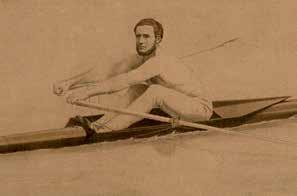
and his local supporters, but Chambers refused to race. Technically Chambers then forfeited his title, but that hollow victory was not accepted by Green.
Green was feted in the UK before returning home, where his racing was reported at length in Australian newspapers. However he quickly drifted into obscurity after his return, and when Edward Trickett won the World Sculling Championship in 1872, it was Trickett who was hailed as Australia’s first world champion. Behind the scenes Green had a role in this win; he had coached Trickett in Sydney beforehand.
Among the contemporary reports about the challenge to Chambers was the following: Green has given several sittings in his boat( the tubular one) for a picture from which a lithograph will be taken. Should he be victorious … the copies will be of great value … Should defeat be the fate … they will be a memento to recall the memory of a man who travelled 10,000 miles to make a match
Having begun to restore Green’s legacy through the ARHV, finding a copy of that memento became a quest for us. It was successful thanks to the register. A Green relative, Mary Mannings, saw the entry about the Star of Australia on the ARHV website, and gave us more information on the family’s background. With it was key evidence that the lithograph might exist. A clipping from Sydney’s North Shore Times of 1990 showed R A W Green’s great-grandson Ken Pharo standing in front of a framed example of the lithograph we sought. Yellow Pages did the rest and when we contacted Ken, he not only confirmed he had the lithograph, but kindly offered it to the museum. It was a gift that we gratefully accepted.
Ken’s lithograph had an excellent provenance. He believed that it had originally belonged to Richard Green’s immediate family, suggesting Green had brought it back from England himself. For many years it hung in the kitchen of a Green family residence they had built
at Eastwood, and when Ken moved from this home in the 1990s, he took the lithograph to the north coast of NSW with him. Over these years it had aged considerably, but our conservators accepted the challenge of stabilising, cleaning and repairing the fabric, the artwork and the frame.
The fact that Henry Green had built the scull himself opened up another part of the story: the many generations of Greens who had been boat builders in Australia and, for a period,
Kukkuburra, an A E Cutler-designed 30-foot linear rater whose shape went off on a tangent no one else followed.
Subsequent generations continued as shipwrights, but the Green name came to prominence again in the 20th century when twins Augustus and Harry set up a yard in Abbotsford on the Parramatta River, and were soon well known for their superior racing sculls and shells. Bobby Pearce, the legendary Australian sculler who was unbeaten at the international level from 1928 through
Green rowed wager races, where backers put up a purse matched by the challenger, open to betting
in New Zealand. Richard and Henry’s father George had come to the colony in 1812 as an apprentice to a shipwright, and married the daughter of another shipwright. He established his own yard on Milsons Point, just to the east of the present location of the Harbour Bridge’s north pylon.
His sons joined him working in the yard, but during the 1850s George settled in Dunedin, New Zealand, where he had large land holdings. He set up another successful yard there. Henry joined him in 1865, and reports from the Otago Times showed that over many years he built sculling and rowing craft for local clubs. He is also credited with the design and construction of three very successful but different yachts; their hull shapes were clearly based on the radical Sydney yacht Australian from 1859, and the Powerhouse Museum in Sydney even has a half-model of one. Clearly Henry Green had unorthodox ideas.
Henry returned to Sydney in the 1890s and set up in Lavender Bay North Sydney. Among the craft he is known to have built were two more out-of-theordinary vessels. One was the launch Wahine, one of the earliest oil-powered craft that had been designed by another man always trying something a bit different, Walter Reeks. Another was
to his retirement after World War II, used A&H Green-built sculls for all his victories from 1930 onwards.
Augustus had two sons, Maurice who remained a shipwright until the 1980s, and Barry, who starred as a sculler at national level in the 1950s, and then remained close to the scene by coaching at schools and repairing craft for many years.
Sculling continued in the family with Richard Green’s great grandson Ken Goswell, a keen sculler who was a world masters champion in the 1980s. The family connection to sculling remains alive; four generation onwards from Richard Green, descendant James Goswell has rowed in school and university crews and represented Australia at the under-23 World Championships.
The museum’s connection to the Green story has since been bolstered by another significant acquisition. One of Bobby Pearce’s A&H Green-built sculls has been acquired from its late owner Paul Waltz in Canada, and the historic craft returned to Australia not long after the Green reunion in January, almost 80 years after it went to Hamilton Ontario where Pearce had settled in 1930. Pearce and this scull is a story by itself, for another time.
SIGNALS 87 June–August 2009 Page 20
Message to Members
From Members manager Adrian Adam


WELCOME to another quarter of activities and events for you to enjoy – we try not to let the cooler weather slow us down, so there is lots for you to do and see over the winter months. See the following pages for booking details, times and prices.
The first two essays in this issue of Signals explore our newest exhibition Exposed! The story of swimwear, which highlights designs and designers, past and present, at the forefront of Australian swimwear fashion. Blurring the boundaries between underwear and outerwear, the swimsuit continues to make shock waves – as I’m sure you’ll agree!
The exhibition Charles Darwin – Voyages and ideas that shook the world continues until August and we have programmed lectures, curator talks and gallery tours so you can enjoy some
activities and a rather large birthday cake. There’s more to read about Vampire in these pages.
Join us at the Opera House for a special combined movie and concert: Sergei Eisenstein’s classic silent 1925 film Battleship Potemkin, accompanied by the music of Shostakovich performed by Sydney Symphony, on Saturday 31 July. We’ve obtained Member discounts for this revolutionary film set in a revolutionary time.
Other events include our annual beer tasting and tour of the Malt Shovel Brewery at Camperdown with master brewer and museum sponsor Chuck Hahn, brewer of the James Squire range – a connoisseur’s delight. On the water we will go whale watching once again, and we will also visit spectacular Spectacle Island to check out its naval history – always popular, so book early.
Blurring the boundaries between underwear and outerwear, the swimsuit continues to make shock waves
of the superb material on loan from leading collections including the British Museum, the National Maritime Museum at Greenwich UK, the Oxford University Museum of Natural History, the National Library of Australia and the State Library of New South Wales. Don’t forget to check out the glasshouse with its live, insect-eating plants!
In June the largest museum object in Australia, HMAS Vampire, reaches the 50th anniversary of its commissioning. A weekend of celebrations begins on Friday 19 June with a traditional naval dinner led by special guest, Deputy Chief of Navy RADM Davyd Thomas AO CSC RAN. A seminar on Saturday will feature many former Vampire COs speaking about their days in service, and afterwards an RAN band performs a Sunset Ceremony. Sunday will be a family day with lots of fun and
For Members children we continue our after-dark torchlight tours, led by our actor-in-residence as caretaker Spanker Boom who will shed light on what really happens in the museum after dark. And we have a wonderful new event for kids called Fishing 4 Kids! Supported by the NSW Department of Primary Industries and the Recreational Fishing Trust, this workshop teaches responsible fishing practices to children, who will get a chance to catch some of those fish around the museum wharves. It will be both enjoyable and educational.
ABOVE RIGHT: Just about everyone was a winner in the traditional lucky door draw at our reception for new Members in the Terrace room last April, with prizes donated by our many generous sponsors including Coral Sea wines and James Squire beers.
ABOVE LEFT: New Members Garry and Margaret Kirkman are serenaded by our entertainers The Enchanted Zone, Olga Conrad and Alfredo Scognamiglio. Photography J Mellefont/ANMM
Page 21 SIGNALS 87 June–August 2009
Events for Members

How to book
It’s easy to book for the Members events on the next pages … it only takes a phone call and if you have a credit card ready we can take care of payments on the spot.
• To reserve tickets for events call the Members office on 02 9298 3644 (business hours) or email members@anmm.gov.au. Bookings strictly in order of receipt.
• If paying by phone, have credit card details at hand.
• If paying by mail after making a reservation, please include a completed booking form with a cheque made out to the Australian National Maritime Museum.
• The booking form is on reverse of the address sheet with your Signals mailout.
• If payment for an event is not received seven (7) days before the function your booking may be cancelled.
Booked out?
We always try to repeat the event in another program.
Cancellations
If you can’t attend a booked event, please notify us at least five (5) days before the function for a refund. Otherwise, we regret a refund cannot be made. Events and dates are correct at the time of printing but these may vary … if so, we’ll be sure to inform you.
Parking near museum
Wilson Parking offers Members discount parking at nearby Harbourside Carpark, Murray Street, Darling Harbour. To obtain a discount, you must have your ticket validated at the museum ticket desk.
Members, out on the harbour for the Royal Australian Navy ceremonial fleet entry on 13 March, witnessed what few Sydneysiders ever have – a Collins class submarine, HMAS Farncomb, normally based in Western Australia. Photographer A Adam/ANMM
Members events calendar
June
Fri 19
Sat 20
Sun 28
July
Special: HMAS Vampire anniversary naval dinner
Symposium: HMAS Vampire – story of a ship
Talk: The General Grant ’s gold
Thu 2 Talk & view: Exposed! The story of swimwear
Fri 3
Lunchtime curator tour: Charles Darwin
Sun 12 On water: Whale-watching cruise
Thu 16 On water: Spectacle/Garden Islands naval tour
Thu 23 For kids: Fishing 4 Kids!
Fri 31
August
Special: Battleship Potemkin and orchestra
Thu 6 For kids: After dark torchlight tour
Fri 7
Sun 9
Sun 16
Wed 19
Sun 23
Sun 30
Lunchtime curator tour: Charles Darwin
Talk & film: The Tragic Trio – shipwreck history
Special: David Mearns searches for HMAS Sydney
Tour & tasting: James Squire brewery
Lectures: Farewell to Charles Darwin
Talk: Beneath the Dardanelles – the AE2 story
SIGNALS 87 June–August 2009 Page 22
Lectures & talks
Symposium: HMAS Vampire – the story of a ship and the people who served on her 10:30 am–5 pm Saturday 20 June at the museum
Daring class destroyer HMAS Vampire is Australia’s largest museum vessel, representing the era of big-gun ships now superseded by the modern missile navy. Commissioned on 23 June 1959, Vampire served in the Royal Australian Navy from 1959–1986, steaming a total of 808,026 nautical miles. Explore the history of the vessel, her construction, refits and dockings, and hear the stories of her days in service from the people who served on her. Guest speakers include RADM Steve Gilmore, former Cockatoo Island CEO and historian John Jeremy, and Vampire Association patron and former Chief of Navy VADM David Leach (Rtd), as well as eight former commanding officers from the various eras. Members $50, guests $60. Includes light lunch, afternoon tea, RAN band Sunset Ceremony after the symposium, and evening reception.
The General Grant’s gold –shipwreck and greed in the southern ocean 2–4 pm Sunday 28 June at the museum

The wreck in 1866 of the General Grant in the desolate sub-Antarctic Auckland Islands –reportedly carrying a hoard of gold from the Victorian goldfields – is one of the world’s great nautical mysteries. A handful of survivors lived a hand-to-mouth existence for two long years before being rescued. For 140 years, expeditions and bounty hunters have searched for the ship and her elusive cargo. Hear New Zealand-based author Ken Scadden speak about his new book The General Grant’s Gold, with its tales of heroes and cads, heartbreak and loss, hope and despair, hunger and greed.
Members $15, guests $20. Includes Coral Sea wine, cheese and James Squire beer.
BOOKINGS AND ENQUIRIES
Booking form on reverse of mailing address sheet. Phone 02 9298 3644 or fax 02 9298 3660, unless otherwise indicated. All details are correct at time of publication but subject to change.
Talk & viewing: Exposed! The story of swimwear
6.15–8 pm Thursday 2 July at the museum
Movie sirens, aquatic stars, bathing beauties, athletes, sporting icons, swimmers and designers all played their part in the evolution of the modern swimsuit. Blurring the boundaries between underwear and outerwear, the swimsuit continues to make shock waves. Exposed! places Australian swimwear in a global context, and shows how Australian swimwear designers have responded to the environment, our strong local swimming and beach culture, and international fashion trends. Come and see this new exhibition and hear the story behind it with exhibition curator Daina Fletcher.
Members $15, guests $20. Includes Coral Sea wine, cheese and James Squire beer.
Talk and screening:
The Tragic Trio – a shipwreck history
2–4 pm Sunday 9 August at the museum
The Tragic Trio is a new film by Max Gleeson – renowned maritime historian, underwater photographer and one of Australia’s most experienced wreck divers. It examines the events surrounding a short but disastrous period of Australia’s maritime history (December 1918–May 1919) when three colliers (Undola, Myola and Tuggerah) foundered within sight of the coastline, taking the lives of 26 men. View excerpts from the film, combining stunning underwater footage of the wrecks with archival film and images, and hear Max discuss the evidence from the individual wreck sites for what may have led to the loss of the ‘sixty milers’.
Members $15, guests $20. Includes Coral Sea wine, cheese and James Squire beer.
Lectures:
Farewell to Charles Darwin
1–4.30 pm Sunday 23 August at the museum
To mark the final day of our exhibition Charles Darwin – Voyages and ideas that shook the world, guest speakers explore the world and legacy of Charles Darwin. Speakers include Emeritus Professor Frank Nicholas (author of Charles Darwin in Australia), Dr Paul Brunton from the Mitchell Library, and exhibition curator Dr Nigel Erskine.
Members $20, guests $30. Includes afternoon tea, Coral Sea wine and James Squire beer.

Page 23 SIGNALS 87 June–August 2009
Charles Darwin by George Richmond, 1840. Darwin Heirlooms Trust
Events for Members
Beneath the Dardanelles –the Australian submarine at Gallipoli 2–4 pm Sunday 30 August at the museum

The daring passage of Australian submarine AE2 through the Dardanelles on 25 April 1915 is a rare success story of the Gallipoli campaign. Ordered to ‘run amok’ it managed to avoid capture for five days before being scuttled. Beneath the Dardanelles tells its story from both the Australian and Turkish perspectives. AE2 lay undiscovered on the seabed until 1998 and is the largest Australian relic of the Gallipoli campaign.
Authors Vecihi and Hatice Basarin are joined by Tim Smith, director of maritime archaeology for the 2007 AE2 archaeological expedition.
Members $15, guests $20. Includes Coral Sea wine, cheese and James Squire beer.
Tours
Lunchtime curator tours: Charles Darwin –Voyages and ideas that shook the world 12 noon–1.30 pm Friday 3 July and Friday 7 August
Join one of our two lunchtime curator tours of the Charles Darwin exhibition. Enjoy a discussion over a light lunch and glass of wine in the Members Lounge, followed by a comprehensive guided walk through the exhibition with curator Dr Nigel Erskine.
Members $15, guests $20. Includes light lunch, Coral Sea wine, cheese and James Squire beer.
James Squire: Beer lovers’ tour and tasting 5–7 pm Wednesday 19 August at the Malt Shovel Brewery
Discover how the museum’s beer sponsor Malt Shovel Brewery – brewer of the characterful James Squire range of ales, lagers, pilseners and porter – produce their unique hand-crafted beers. Tour the brewery in Camperdown and learn some secrets of these distinctive beers, based on the traditional methods of Australia’s first brewer, James Squire. Beer lovers will enjoy sampling a range of outstanding brews with our brew-master Chuck Hahn. Book early as this tour is popular and tickets are limited!
Members $15, guests $20. Includes beer and food tasting. Meet at Malt Shovel Brewery, 99 Pyrmont Bridge Road, Camperdown.
On the water
Whale-watching cruise
9 am–12.30 pm Sunday 12 July off the coast of Sydney
Experience the unforgettable thrill of watching whales migrate north along the coast of Sydney. See them up close from the luxury offshore vessel True Blue, a purpose-built whale-watching vessel. A speaker will be on board to provide commentary. Last year there were record sightings, so don’t miss this chance to see these magnificent creatures – and don’t forget to bring your camera!
Members: adults $60, child $35, family (2 adults+2 children) $160. Guests: adults $65, child $40, family $180. BYO picnic. Tea and coffee provided on board. Meet at Festival Pontoon next to submarine HMAS Onlsow. Cruise subject to change depending on conditions. Guaranteed sightings or receive a free replacement cruise!

Spectacle and Garden Islands naval heritage tour
9 am–1 pm Thursday 16 July on the harbour
Spectacle Island lies in the main channel of the western harbour, adjacent to the suburb of Drummoyne. The island is historically significant as it is the oldest naval explosives manufacturing and storage complex in Australia. Originally built to store government gunpower, the island was converted to store naval munitions in 1893, hosting storesheds, jetties and an internal railway system, and later a depository of heritage items of the Royal Australian Navy. Enjoy a guided tour of the island followed by a trip to the harbour’s other naval island, Garden Island, to check out its Naval Heritage Centre, which includes memorials to the midget submarine attack on Sydney Harbour in 1942 and the Australian submarine AE2 lost at Gallipoli in 1915.
Members $55, guests $65. Includes refreshments onboard. Meet at the Festival Pontoon next to submarine HMAS Onslow
BOOKINGS AND ENQUIRIES
Booking form on reverse of mailing address sheet. Phone 02 9298 3644 or fax 02 9298 3660, unless otherwise indicated. All details are correct at time of publication but subject to change.
SIGNALS 87 June–August 2009 Page 24
For kids
Fishing 4 Kids!
10 am–12 pm or 11 am–1 pm Thursday 23 July
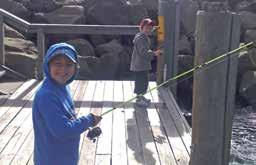
Supported by the NSW Department of Primary Industries and the Recreational Fishing Trust, this workshop teaches children responsible fishing practices. Children will learn about conservation of fish habitats, sustainable fishing, knot-tying, line-rigging and baiting, casting techniques and handling fish. They will also find out about what fish live in and around Darling Harbour – and what they eat. A simple quiz session will provide each child with a prize and fishing tackle to take home, plus a certificate of achievement. Members only, $20, limited numbers. Suitable for children 7–14. Children will be fully supervised by Recreational Fishing Trust education officers during the workshop which will include fishing from our wharves. Morning tea will be provided. Please bring a hat and appropriate footwear.
After-dark museum torch-light tour
5.15–7 pm Thursday 6 August at the museum
Bring your torch for a night of ghoulish adventure at the museum. Meet our long-time museum caretaker Spanker Boom who has wandered the museum after dark for many a year. He’ll shed some light on what really happens in the museum after dark and maybe you’ll discover what goes ‘bump’ in the night! Listen to scary stories and join in some songs and activities along the way. Mums and dads can enjoy a glass of Coral Sea wine and view our Charles Darwin exhibition. Member child $10, guest $15. Includes refreshments and light supper. Suitable for children 3–8. Bring along your torch!
Special events
HMAS Vampire 50th anniversary naval dinner
7.30–11.30 pm Friday 19 June at the museum
Celebrate the 50th anniversary of the commissioning of HMAS Vampire at this black-tie event combining naval tradition, fine food, wines and port, music and ceremony, including a ‘toast to the ship’ by Deputy Chief of Navy RADM Davyd Thomas. Museum Chairman Capt Peter Sinclair (Rtd) will be your dinner president, ably assisted by museum Council naval representative RADM Steven Gilmore as vice-president. A contingent of the Royal Australian Navy band will perform during dinner. Members $165, guests $180. Meet in the foyer from 7.30 pm.
Movie and concert: Battleship Potemkin and the Sydney Symphony Orchestra
8 pm Friday 31 July at the Sydney Opera House Concert Hall

Sydney Symphony Orchestra invites Members to a special screening of Sergei Eisenstein’s classic silent film Battleship Potemkin, accompanied by the music of Shostakovich. A revolutionary film set in a revolutionary time, Battleship Potemkin was made in 1925 and was banned in several countries due to its incendiary content. It might be propaganda – it quotes Lenin, and its sailor hero has an uncanny resemblance to Stalin –but the emotive power of this influential masterpiece is undiminished.
The orchestra will play excerpts from Shostakovich’s Fourth, Fifth, Tenth and Eleventh symphonies in a definitive new arrangement by conductor Frank Strobel.
Special offer: Members exclusive 20% discount, 31 July only: A Reserve $98, Members $88; B Reserve $88, Members $79; C Reserve $68, Members $61. Bookings: Box Office 8215 4600. Must advise you are an ANMM Member and quote 1934 to receive this offer. Available until 5 pm 10 July or while stocks last (a booking fee may apply). Battleship Potemkin is rated PG.
Search for HMAS Sydney, with David Mearns
2–4 pm Sunday 16 August at the museum
For 66 years it has been Australia’s greatest maritime mystery: what happened to the pride of the World War II fleet, HMAS Sydney. David Mearns has built a formidable reputation as the world’s foremost shipwreck hunter, hunting down 21 major ships, but finding the Sydney proved his toughest challenge. For the first time, David tells of his role in finding both Sydney and Kormoran, capping an epic six-year journey in his new book featuring never-seen-before photographs taken by David of the wrecks 2,500 metres under the sea.
Members $15 guests $20. Includes Coral Sea wines and James Squire beer
EMAIL BULLETINS
Have you subscribed to our email bulletins yet? Email your address to members@anmm.gov.au to ensure that you’ll always be advised of activities organised at short notice in response to special opportunities.
Page 25 SIGNALS 87 June–August 2009
What’s on at the museum
Winter school holidays 12–26 July 2009
Discover Mr Darwin Hourly sessions 10 am–4 pm daily
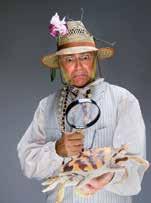
Free family movie 1.30 pm daily
In conjunction with our exhibition Charles Darwin –Voyages and ideas that shook the world, find out about his amazing voyage of discovery on the Beagle Learn what it takes to be a junior naturalist – sort, collect, investigate and discover! For children 5–12 years. $7 per child or FREE with any purchased ticket. Adults/ Members FREE
A FREE selection of classic short animations: Butterfly Ball, The Owl and the Pussycat, The Figurehead, and The Stowaway (26 minutes). Check www.anmm.gov.au/ film for details.
Vampire flix by the Vampire
7.30 pm Thursday 11, Friday 12 & Saturday 13 June
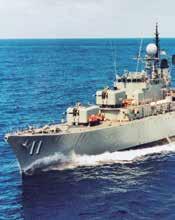
Feast on a trilogy of classic Vampire flix alongside HMAS Vampire. See cult blaxploitation film Blacula, 80s favourite The Lost Boys and the latest blockbluster Twilight. Bring a picnic or dine alfresco at Yots waterside café. Midwinter outdoor screenings, so rug up – and keep your necks covered!
Tickets from $15. Bookings essential 9298 3655
Junior naturalist workshop week
9.30 am–4 pm Monday 20–Friday 24 July
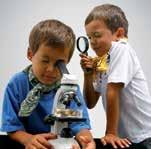
Charles Darwin spent five years aboard the Beagle discovering new plants and animals, all around the world. Take five days to become a junior naturalist, and discover the hidden secrets of natural science! Work with artists from Circus Solarus to create a massive ship-sculpture from ‘discovered objects’ to sail around the museum. For budding scientists and creative children 8–12. $250 per child. Members/early bird discount $225. Bookings essential 9298 3655
SPECIAL GROUP RATES
For groups of 10 children or more. $7 per child for a fully organised program of activities that includes:
• all museum exhibitions
• all children’s daily activities
• entry to HMB Endeavour replica, destroyer Vampire, submarine Onslow
• FREE entry for 2 adults per 10 children
• FREE bus parking
NB $4 extra per child for Endeavour and James Craig
Bookings essential. Book early to ensure your place! Phone 02 9298 3655 fax 02 9298 3660 email: bookings@anmm.gov.au
Family day: HMAS Vampire 50th anniversary 10 am–4 pm Sunday 21 June
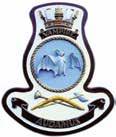
Daring class destroyer HMAS Vampire represents the era of big-gun ships now superseded by the modern missile navy. Built 1952–56 at Cockatoo Island Dockyard, Vampire was launched in 1956 and commissioned on 23 June 1959. We celebrate the 50th birthday over the weekend of 19–21 June. Bring the kids along to a special family day on Sunday with activities for everyone including discounted entry to the ship, live music by the RAN Band, children’s activities and much more!
FREE activities with discounted entry to HMAS Vampire 02 9298 3655
SIGNALS 87 June–August 2009 Page 26
Winter 2009 program
Special events
During school term
Family fun Sundays
11 am–3 pm every Sunday during term
Find out about Charles Darwin’s amazing voyage of discovery on the Beagle. Learn what it takes to be a junior naturalist – sort, collect, investigate and discover! For children 5–12 years. $7 per child or FREE with any purchased ticket. Adults/Members FREE
Mini Mariners
10–10.45 am and 11–11.45 am
Two sessions every Tuesday during term
June – Pirates ahoy! Let’s follow the treasure map around the museum to find out where the secret loot is hidden. Then you can make your own treasure chest to take home. Come dressed the part to double the fun. July – Sail around the world Grab your passport and let’s set off on an adventure to foreign lands!
August – By the sea shore Join in this new Mini Mariners program as we imagine what we can find by the sea shore. For children 2–5 + carers, $7 per child. Adults/Members FREE. Bookings essential 02 9298 3655. Booked playgroups welcome. Please note this program is not offered during the school holidays and for safety reasons is held inside the museum.

Pirate treasure hunts
11 am–12.30 pm and 1–2.30 pm Sunday 28 June
Young castaways will be led by a pirate guide on a hunt through our galleries. Use the clues on the map to find the hidden treasure and make a pirate bandanna to take home. Children 5+. $10 per child/$5 per Member child. Bookings essential 02 9298 3655
Free family movie
1.30 pm every Sunday during term
June 7, 14 & 21 Charles Darwin explains the diversity of life
June 28, July 5 The Dragons of Galapagos
August 2, 9, 16, 23 Million Dollar Mermaid
Visit www.anmm.gov.au/film for details.
Celebrate NAIDOC Week with storytelling 10–11.30 am Tuesday 7 July

Mark NAIDOC Week, the annual celebration of Indigenous cultures, with a special Mini Mariners program. Join our Indigenous storyteller Marlene Cummins as she brings her ancestors’ stories to life, and enjoy some music and craft. The theme for NAIDOC 2009 is ‘Honouring our elders, nurturing our youth’, so bring your grandparents and grandfriends along too!
Children 2–5 + carers. $7 per child. Adults/Members FREE. Bookings essential 02 9298 3655. Booked playgroups welcome
International Lighthouse Day 11 am–3 pm Sunday 16 August
Experience International Lighthouse Day in style. Take a tour inside the historic 1874 Cape Bowling Green Lighthouse and learn the secrets of Morse Code.
FREE
Togs, trunks and bathers – the Aussie response 10 am–12.30 pm Wednesday 19 August
Once it was ‘cover up’, now it’s ‘show off’! Learn how Australian swimwear designers have responded to our environment, our strong Australian beach culture, and international trends in swimwear fashion. Senior curator Daina Fletcher will describe the concept and evolution of Exposed! The story of swimwear, curator Penny Cuthbert will talk about the evolution of the modern swimsuit, and Dr Christine Schmidt will focus on contemporary Australian swimwear designers. Cost $39. Includes morning tea, guided tour of exhibition, and screening of Annette Kellerman’s last film Venus of the South Seas (courtesy Grapevine Video). Bookings essential WEA 02 9264 2781
Program times and venues are correct at time of going to press. To check programs before your museum visit call 02 9298 3777.
Page 27 SIGNALS 87 June–August 2009
The Macassan prahu by Dhuwarrwarr Marika, linocut 2006. ANMM collection
Winter 2009 exhibitions
In our galleries
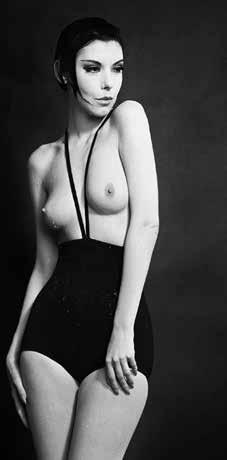
Exposed!
The story of swimwear
2 July–25 October 2009
South Gallery
Movie sirens, aquatic stars, bathing beauties, athletes, swimmers and designers have all played their part in the evolution of the modern swimsuit. Exposed! places Australian swimwear in a global context of design and swimming history and popular culture, and features swimwear by established and emerging designers who have created work especially for the exhibition. Australian National Maritime Museum travelling exhibition
Charles Darwin – Voyages and ideas that shook the world
20 March–23 August 2009 Gallery One and North Gallery
On the 200th anniversary of Charles Darwin’s birth and 150 years after the publication of his famous evolutionary theory
On the Origin of Species, join Darwin aboard HMS Beagle on the voyage of a lifetime. Explore the world of Darwin and his colleagues and see how their work continues on new scientific frontiers
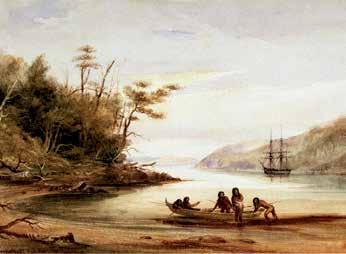
The last RoRos into the Port of Sydney
Until 28 June 2009 Tasman Light Gallery
For more than 30 years motor vehicles have come into Sydney on roll-on/roll-off car and truck carriers. On 15 November 2008 the last shipment was unloaded at Glebe Island and the vehicle trade was moved to Port Kembla, 100 km south of Sydney. ANMM photographs celebrate the work of these distinctive vessels and capture the end of an era for Sydney Harbour.
NAIDOC 2009 –celebrating and acknowledging Indigenous Australians
1 July–1 November 2009
Tasman Light Gallery
In 1606 the Dutch ship Duyfken landed the first Europeans on Australian soil. Four centuries later, ten of Australia’s talented and emerging Indigenous artists have produced a portfolio of prints recognising this contact. NAIDOC is an annual celebration of Indigenous cultures.

On the water
Replica of James Cook’s HMB Endeavour
Open daily 10 am–4 pm from 27 June
Experience 18th-century life in the Royal Navy on board the museum’s magnificent Australian-built replica of Captain James Cook’s ship. (View rigging work from the wharf while the ship is closed for a refit until 26 June.)
Members FREE.

Adults $15, child/concession $8, family $30. Other ticket combinations available. Enquiries 02 9298 3777
Barque James Craig (1874)
Daily Wharf 7 (except when sailing)
Sydney Heritage Fleet’s magnificent iron-hulled ship is the result of an award-winning 30-year restoration. Tour the ship with various museum ticket packages (discount for Members). The ship sails alternate Saturdays and Sundays.
Check www.shf.org.au for details.
ANMM travelling exhibitions
Joseph Banks and the flora of the Australian east coast
25 July–6 September 2009
Gippsland Art Gallery, Sale, Victoria
Engravings of Sydney Parkinson’s exquisite original botanical drawings from Cook’s first voyage.
Great White Fleet – US sea power on parade 1908
Until 28 June 2009
Fremantle History Museum, Western Australia
Teddy Roosevelt’s visiting fleet was greeted with great fanfare by Australians.
Peggy Moffitt modelling Rudi Gernreich topless swimsuit 1964. Photograph by William Claxton. Courtesy Demont Photo Management (www.demontphoto.com)
Portrait Cove, Beagle Channel, Tierra del Fuego , Conrad Martens, 1834. National Maritime Museum, UK Peggy Moffitt modelling Rudi Gernreich topless swimsuit, 1964 Photograph by William Claxton Courtesy Demont Photo Management Gawarrk by Dulamari (Djalinda Yunupingu) 2006 ANMM collection SIGNALS 87 June–August 2009 Page 28
Watercolour by Ross Shardlow
For schools
Over 30 programs are available for students K–12, across a range of syllabus areas. Options include extension workshops, hands-on sessions, theatre, tours with museum teacherguides and harbour cruises. Programs link to both core museum and special temporary exhibitions. Bookings essential: telephone 02 9298 3655 fax 02 9298 3660 email bookings@anmm.gov.au or visit our website: www.anmm.gov.au
Maritime archaeology
Years 5–12 History, Science
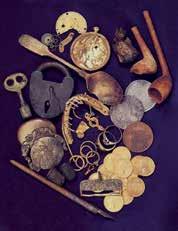
In this hands-on workshop students use a mock seabed and examine objects as a way of exploring unwritten records of the past. Students learn about the process of maritime archaeology, conservation and interpretation of material history. Programs are available for both primary and secondary students.
$10 per student (Years 5–6),
$12 (Years 7–10),
$15 (Years 11–12)
Charles Darwin – Voyages and ideas that shook the world
Years 3–12 HSIE, Science, History, Geography

In the 200th anniversary year of Charles Darwin’s birth and 150 years after the publication of his famous evolutionary theory On the Origin of Species, join Charles Darwin aboard HMS Beagle for the voyage of a lifetime. Discover the world of Darwin and his colleagues and see how their work continues on new scientific frontiers today. Visiting school groups can explore the exhibition through special guided tours and workshops across several curriculum areas. For a full list of programs visit the Education section of our website: www.anmm.gov.au
Transport
Years K–2 HSIE, Science
Students tour the museum identifying various forms of transport connected with water – sailing ships, row-boats, ferries, tugs, a Navy destroyer, water traffic and even a helicopter! An optional cruise by heritage ferry takes in industrial, commercial and passenger transport systems on the harbour.
$6 per student (cruise extra)
Years

people of north-east Arnhem Land in the Northern Territory have shared their sacred knowledge of sea country in a series of bark paintings that reflect their special connection to their environment. Several of the paintings have been used as legal documents in sea-rights court cases. Students learn how the artists use symbols in their art to express this connection and share it with non-Indigenous people. Students view some of the paintings in our Eora gallery then create an artwork about their own special place.
$10 per student. Includes workshop and tour
Pyrmont walk
Years 9–12 History, Geography
Explore this inner-city suburb from the perspective of changing demographics, construction, planning and development. Led by a teacher-guide, students walk the streets of Pyrmont and examine changes. The program is suitable as a site study for History and Geography. A harbour cruise examining change and development along the waterfront is also available.
From $12 per student (cruise extra)
Splash!
Years K–2 HSIE, PD, PE and Health, Creative Arts
Splash! is a hands-on program where younger visitors explore leisure in, on, under and near the water through movement, dress-ups, games and stories. The program includes a guided tour of the Watermarks exhibition and students make their own themed craftwork to take home.
$8 per student
Science and the sea
Years 6–8 Science
This program demonstrates key scientific principles that relate to a maritime environment. Working through a series of activity stations, students cover areas such as buoyancy, corrosion, navigation and communication. A tour of the museum allows students to see these scientific principles in action.
$12 per student, includes submarine tour
My special place
5–10 Visual Arts, History, HSIE
The Yolngu
Dunbar shipwreck artefacts ANMM collection Detail of Gapuwarriku at Lutumba by Dhukal Wirrpanda ANMM collection Page 29 SIGNALS 87 June–August 2009

SIGNALS 87 June–August 2009 Page 30
It took more than two centuries to publish the exquisite botanical watercolours of artist Sydney Parkinson, engaged by Joseph Banks for James Cook’s first Pacific voyage. The museum’s copies of these wonderful works are now touring the country. Senior ANMM curator Lindsey Shaw introduces them.

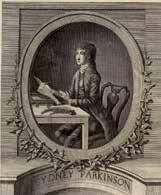
JOSEPH BANKS – naturalist, patron of science and ‘gentleman of large fortune’ – accompanied James Cook on his first Pacific voyage in 1768–1771. He subsidised the expedition to the amount of £10,000 – millions, in today’s values –by funding the employment of Daniel Carl Solander (naturalist), Sydney Parkinson (natural history artist), Alexander Buchan (landscape artist), Herman Spöring (secretary and artist), and four field assistants. It was a voyage of discovery that would excite the scientific community with its abundance of new species of plants and animals, and fire the public imagination as well.
During his time with the expedition, Sydney Parkinson completed some 1,300 sketches and watercolours of botanical specimens and landscape views, and also compiled vocabularies of the peoples of Tahiti and New Zealand. Sadly, he died on the return leg of the voyage.
Born in Scotland in 1745, the young Parkinson was apprenticed to a wool draper but in his spare time learnt the specialised art of botanical drawing. In 1766 he moved to London to pursue his natural history studies. It was not long before he came to the attention of Joseph Banks, who offered him a job at the Royal Botanic Gardens at Kew and subsequently invited him to join Cook’s expedition to the Pacific.
During the first part of the voyage, Parkinson was able to sketch the botanical specimens and then complete watercolours of them. After the death of landscape artist Alexander Buchan (who died of an epileptic fit in Tahiti in 1769), Parkinson was required to perform Buchan’s duties as well as his own. With so many new botanical species to record, he soon fell behind and was only able to complete detailed annotated sketches. He also had to work quickly
before the specimens dried out and lost their colour or shape – and in some cases before insects ate the specimen and his paints as he worked! Parkinson recorded both plants and animals, from the sea and land.
Parkinson’s intention was to complete the watercolours when he returned to England, but when Endeavour called in at Batavia (now Jakarta) in Java on the homeward voyage, he contracted dysentery. He died on 26 January 1771, aged just 26, and was buried at sea.
ABOVE LEFT: Sir Joseph Banks Esquire Mezzotint from a painting by Sir Joshua Reynolds (engraved by W Dickinson), 1774. ANMM collection
ABOVE RIGHT: Sydney Parkinson, from the frontispiece of A Journal of a Voyage to the South Seas, in His Majesty’s Ship, the Endeavour, published by his brother Stanfield in 1773. ANMM collection.
Page 31 SIGNALS 87 June–August 2009

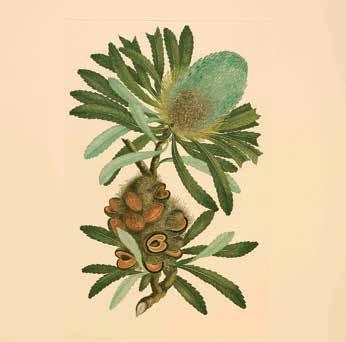
Three of the museum’s exquisite prints from Banks’ Florilegium currently touring Australia. PAGE 32: Plate 84 Castanospermum australe; ABOVE LEFT: Plate 244 Deplanchea tetraphylla; ABOVE RIGHT: Plate 285 Banksia serrata © Natural History Museum, London. ANMM collection. Gift from Dr Eric and Mrs Margaret Schiller.
Parkinson’s brother Stanfield later became embroiled in an acrimonious battle with Sir Joseph Banks over his brother’s personal effects, papers and drawings. Banks paid out the balance of Sydney’s salary and returned some of his personal papers, but refused to let Stanfield have the drawings. Banks’ argument was that Sydney had been paid as botanical artist and the works therefore belonged to Banks.
specimens. He was elected president of the Royal Society in 1778 – a position he held until his death in 1820 – and was created a baronet in 1781. Banks was influential in the British government’s decision to colonise New South Wales, corresponded with missionaries going to the Pacific region, and funded ‘gentlemen’ collectors and naval expeditions to various parts of the world.
He was a man with many fingers in many pies. Between 1772 and 1784 he employed five artists – John Frederick Miller, Frederick Polydore Nodder, Thomas Burgis, John Cleveley and James Miller – to complete Parkinson’s watercolours, and no fewer than 18 engravers to cut copper printing plates, with a view to publishing the works in full colour. Banks and Solander jointly
Banks employed five artists to complete Parkinson’s watercolours and 18 engravers to cut copper printing plates
In an act more reminiscent of a soap opera, Stanfield managed to gain access to some of his brother’s papers and in 1773 published A Journal of a Voyage to the South Seas. This was the same year in which the official account of the voyage was published by John Hawkesworth –who did not acknowledge Sydney Parkinson’s papers or drawings at all.
Banks became a leading light in the natural history field, advising on the development of the Royal Botanic Gardens at Kew (among a myriad of other projects). Many other botanists sent him their own
selected the specimens based on their importance to science. However the publication never eventuated and the original watercolours along with the plant and animal specimens were deposited with the British Museum in 1827. They were relocated to South Kensington in the late 19th century when the British Museum’s Department of Natural History became a museum in its own right (the Natural History Museum).
For more than a century the works remained unpublished, until in 1900 James Britten published Illustrations
of Australian Plants using 318 of the engravings – however in monochrome only. In 1973 Captain Cook’s Florilegium was published using 30 of the engravings, but still in black ink. It seemed that Parkinson’s work would never see the light of day in all its true glory.
Fortunately for us, between 1980 and 1990 Alecto Historical Editions in partnership with the Natural History Museum published the works in 35 parts comprising 743 botanical drawings, 337 of which feature Australian plants. The collection is known as Banks’ Florilegium and records the plants collected by Banks and Solander in Madeira, Brazil, Tierra del Fuego, the Society Islands, New Zealand, Australia and Java. The collecting points along Australia’s east coast ranged from Botany Bay to Booby Island, with a great majority of the specimens being collected from the Endeavour River region when Endeavour had to undergo repairs after striking the reef.
One of the most interesting features of the publication process is that the original plates commissioned by Banks were themselves used to produce these engravings. Only 100 numbered sets of the Florilegium were produced, and this museum is privileged to have a complete set of the Australian part, thanks to the generosity of our donors Dr and Mrs Schiller.
Banks’ Florilegium is a cornerstone in the study of Australian natural history and is truly a delight for gardeners, botanists and artists alike.
SIGNALS 87 June–August 2009 Page 32
Taking Banks’ Florilegium to the nation
The latest addition to the museum’s Sail Away program of travelling exhibitions are the lovely engravings pictured on the previous pages. Coordinator of temporary and travelling exhibitions Niki Mortimer describes the museum’s approach to sharing them with the nation.
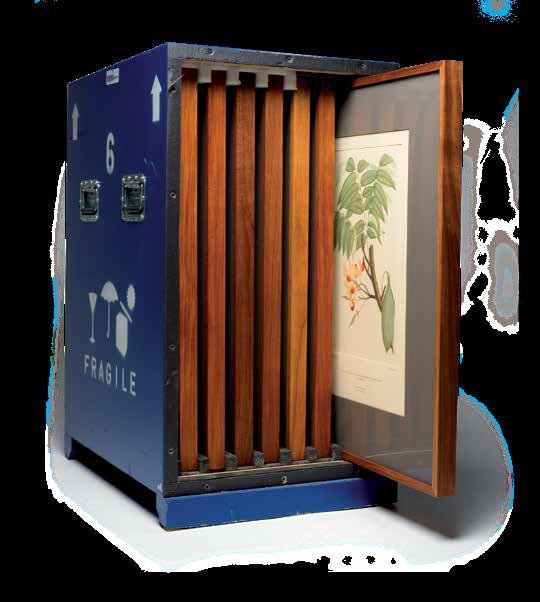
SAIL AWAY is a program of pictorial exhibitions, drawn from the Australian National Maritime Museum’s collection, that travel nationally. This is one of the very important outreach initiatives through which the museum engages with the wider Australian community, part of its brief as a national collecting and cultural institution. Our collections and programs aren’t just for Sydney, where we happen to be located, but are resources that must benefit the nation.
The Sail Away exhibitions are first displayed in our temporary gallery spaces before touring to metropolitan and regional art galleries, museums and cultural centres around the country. Previous travelling exhibitions have included such diverse subjects as American war-time lithographic posters, Walter Stackpool’s vivid watercolours of marine species found in Australia’s waters, and dramatic photographs of the Antarctic by Frank Hurley and Herbert Ponting.
Joseph Banks and the flora of the Australian east coast contains 37 coloured engravings of Sydney Parkinson’s original drawings that recorded the coastal plants collected between Sydney and far north Queensland by Sir Joseph Banks and Dr Daniel Carl Solander on Lieutenant
Travelling crate with Florilegium print.
Page 33 SIGNALS 87 June–August 2009
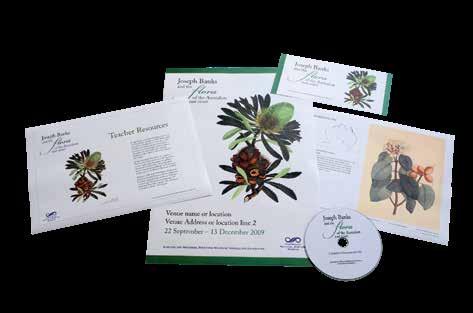

James Cook’s voyage around the world between 1768–1771. The engravings were reprinted from the original plates between 1980 and 1990 by Alecto Historical Editions and the British Museum of Natural History. They are described in more detail in the article on the previous pages by senior curator Lindsey Shaw.
The initial promotion of Joseph Banks to venues around Australia was met with a phenomenal response, with many potential venues expressing keen interest in taking the exhibition. An itinerary was then developed to include as many of these venues as possible, and following a carefully planned route to minimise freight costs to three states. Sail Away exhibitions are designed to tour without ANMM staff to install them, also helping to keep our costs to a minimum.
Joseph Banks was developed for tour by an exhibition team made up of staff from across the museum – travelling exhibitions coordinator, curator, conservator, registrar, designer and representative of our marketing and a visitor programs sections.
The curator selected the engravings from the Australian part of Banks’ Florilegium, which features 337 Australian plants.
These engravings were then mounted and framed by the conservator. The framed engravings travel in crates specially designed to protect the valuable collection material, and for ease of handling. The works are installed by staff of the host venues.
Joseph Banks travels with an extensive kit of resources developed by the exhibition team to assist the venues
key learning areas such as creative art, science, and geography for both primary and secondary students.
Joseph Banks is also the first-ever ANMM travelling exhibition to tour with resource material and advice for offering accessible programs specially for people with disabilities. This material was developed by a University of Sydney student while completing a museum
The use of embossed prints as a resource for visitor activities is a new innovation for this museum
on the tour with promoting the exhibition. So along with object labels, information panels, a map, a portable, pull-up banner and an installation manual, each venue is provided with a copy of the exhibition resource kit, which includes marketing material such as a news release, poster and invitation templates, and publicity images.
Teacher resources are also supplied to venues or can be accessed via the museum’s website. These consist of information and activity cards which are designed to encompass numerous
studies internship with the coordinator of temporary and travelling exhibitions. It represents the culmination of a scoping study into access considerations when developing and producing temporary and travelling exhibitions. Incorporating such accessible programs into a venue’s visitor services creates an environment of inclusion that broadens potential audiences.
The resources for these accessible programs include general information about visitor access, guidelines for hosting a verbal-description tour
SIGNALS 87 June–August 2009 Page 34
OPPOSITE: Material from the exhibition resource kit includes teacher resource material, poster and invitation template, and a portable exhibition banner for use in participating venues.
RIGHT: Accessible programs resource material – banksia pods, embossed prints and magnifying glasses.
BELOW: ‘Picture In A Flash’ (PIAF) machine printing an embossed image.

for people who are blind or have low vision, guidelines for hosting a touch tour, and a list of further reading and resources. For many people, touch is their primary means of acquiring information or accessing an object or work of art, while for others tactile experiences help to complete their mental image of an object.
It is not possible to touch the Florilegium prints themselves, so the touch resources that accompany Joseph Banks – such as banksia pods, embossed images based on the Florilegium prints, and magnifying glasses to help visitors engage more closely with the finer details of the prints – offer a different way of experiencing the exhibition and assist in the delivery of the content.
The use of embossed prints as a resource for visitor activities is a new innovation for this museum. The prints are made using a ‘Picture In A Flash’ (PIAF) embosser. An image is drawn onto paper then photocopied onto special capsule paper. This paper is then passed through the PIAF where the heat reacts with the image on the capsule paper to raise the printed lines. The result is an embossed surface which can be offered to people to touch.

First stop on the Joseph Banks tour is Albury Library Museum, and over the next three years the exhibition will visit Gippsland and Geelong Art Galleries in Victoria, Redcliffe Museum in Queensland, and Western Plains Cultural Centre in Dubbo, NSW, to name just a few. Through our Sail Away program, the ANMM collection is able to extend its outreach to a far wider audience than would be able to visit the museum here
in Sydney. And that audience is extended even further thanks to the accessible program component.
We gratefully acknowledge the assistance of education and visitor services staff at the Powerhouse Museum, Sydney, in producing the embossed prints, and thank the Powerhouse for making their PIAF machine available to us.
Page 35
SIGNALS 87 June–August 2009
HMAS Vampire
50 looking good at
It’s 50 years this June since our Daring class destroyer HMAS Vampire was commissioned. Senior curator Lindsey Shaw describes the process of preserving and restoring the last of the Australian big-gun ships to its former glory, and wishes Vampire a happy 50th birthday!

TUESDAY 23 JUNE 1959 was a great day for the Royal Australian Navy, when the new Daring class destroyer HMAS Vampire underwent its commissioning ceremony, having spent the previous day showing off its wares to the Minister of State for the Navy, Senator the Honourable J G Gorton.
In December 1946 Australia committed to the construction of its own Daring class warships, based on a late-World-War-II British design. Vampire was originally ordered in September 1948 from Cockatoo Docks & Engineering Co Pty Ltd, where the ship was designated No. 189. It was not until 1 July 1952 that the keel was laid, and amid great fanfare and ceremony the ship was launched on 27 October 1956 under the steady hand of Her Excellency Lady Aileen Slim, wife of the then Governor-General Sir William Slim. The final fitout, modifications and sea trials occupied the additional years before commissioning.
And now, 50 years after that commissioning into the RAN – after varied duties and two major mid-life refits to adapt the ship to Australia’s evolving defence requirements – the museum is proud to honour this great warship, the last of the three Daring class destroyers built in Australia, and the sole surviving example of that era of Australian naval design and construction.
As one staff member said recently, ‘Once there were so many and now there are so few left.’ To put our project of preserving the ship in perspective, there are 13 destroyers and destroyer escorts that are represented in an American-led association for preserved naval ships called the Historic Naval Ships Association that now has a worldwide membership. Ten of them are in the USA, one is in England, one is in Canada –
SIGNALS 87 June–August 2009

and then there’s Vampire. Of the 13 ships, Vampire is the second youngest – by two months. (The USS Turner Joy was commissioned in August 1959.)
Vampire has actually been at our wharves since 1990 – before the museum building itself was fitted out and opened to the public. Before that it had lain in the naval ‘graveyard’ at Athol Bight off Taronga Park Zoo, after being decommissioned in 1986. That’s where we first inspected the ship, while in early discussions with the Royal Australian Navy about a proposed experiment that has proved to be highly successful: joining forces to preserve the last of the big-gun ships, and gauging the public’s response to turning a warship into a museum ship. It would become a nautical time capsule of sorts, both for those who have no experience of naval service and for those who lived through it.
While in Athol Bight, before the plan to display Vampire at the museum was developed, the ship had been stripped of many operational components. We have spent the intervening time recreating the ship’s details to allow visitors a glimpse of day-to-day life aboard such a vessel. Our mission is a prodigious one, when you consider that the ship is 118 metres (389 feet) long, 13 metres (43 feet) at its widest point and carried more than 300 officers and sailors.
Made of steel and aluminium, Vampire displaces some 2,800 tonnes and is floating in a highly corrosive medium –Darling Harbour. Parts of its innards are in disarray, its engines and boilers are silent, and we have an ongoing restoration and maintenance schedule aiming to bring it as close to its former glory as we can.
Slowly and steadily we are replacing and restoring missing parts with authentic vintage materials where possible –
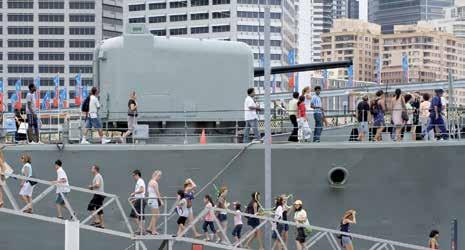
our Fleet section is extremely adept at working through RAN stores and ships as they come up for decommissioning, sourcing components that will be suitable for our destroyer. Aboard, crews of volunteers and staff scrape, paint and toil to restore and maintain the old grey warship.
The HMAS Vampire Association meets regularly at 1100 hours on the first Sunday of the month in the Bat Cave (a former radar room next to the operations room). A ship’s working party also stands to on this day, ‘out pipes’ (gets down to work) at 0800, concludes with stand easy,
45 days in dry dock at Garden Island. It included major programs of work to monitor and assess the ship’s condition, and maintain its safety and integrity afloat as the nation’s largest museum object. These included doubling some thinning hull plates and very extensive work on protective paint systems.
Due to the nature of Vampire’s construction there is only limited access on board for people in wheelchairs. Visits to the ship involve some ladders
Crews of volunteers and staff scrape, paint and toil to restore and maintain the old grey warship
and ‘up spirits’ (the signal for the rum issue, mostly observed here with coffee or a beer at lunch) at 1100. There is also an additional working party on the first Monday of the month from 0800 to 1200 for those unable to make it along to the Sunday working party.
With the ship having been floating for well over the half century since commissioning, there are obviously many areas of considerable wear and tear. These tell part of the story of the ship’s history. As long as they are stable and don’t threaten the vessel’s survival we try therefore to retain as much of the historical fabric and character as possible, while balancing future preservation needs. Sometimes that is a hard juggling act! With a visitation averaging some 3,000 per month we are constantly working on some part of the ship.
Major refits are an expensive and timeconsuming undertaking. The last one took place in 2006 over a period of some
and small compartments but with the dedicated assistance of our highly and frequently acclaimed volunteer guides (meet one of them in the following pages), the ship is brought to life with explanations and stories of events and people.
Vampire, with its original armaments and configuration, stands as silent testimony to historic events. Our Daring class ship has been preserved as a tribute to all destroyers and to those who served aboard them, as well as to the men and women of the Royal Australian Navy, past, present and future. Just as important as preserving this historic vessel physically is the legacy that we leave in the hearts and minds of our visitors. With the combination of museum staff, volunteers and the Vampire Association our destroyer is in excellent hands, making it one of the premier historic naval ships on display in the country.
Happy birthday HMAS Vampire!
Crowds visit Vampire on Australia Day this year. Encapture photography.
Page 37 SIGNALS 87 June–August 2009
Memoirs of a Vampire veteran
Museum volunteer guide Len Price served on HMAS Vampire during some of the most significant segments of the destroyer’s history – from sea trials and commissioning to service in Borneo and Vietnam. He spoke to Signals about life on ‘The Bat’ then and now.

I FIRST joined the Vampire in October 1958 with a group of others, and we became the navy’s trials crew that took her to sea for the very first time, and operated all the equipment for the makers. This went on until that day in June 50 years ago when we commissioned the ship into the Royal Australian Navy. I served on Vampire from that time, up until the end of 1960.
When I joined the ship I was an ordinary seaman – very basic – and I think I have the honour of being the only person who had his helmsman’s certificate removed because I turned the wheel the wrong way! I had to requalify for my helmsman’s certificate, but I survived that to become an able seaman.
As a seaman, you mainly do painting and scraping and cleaning, and odds and ends around the ship. So the daily routine which started in harbour would begin at 8.15 in the morning, and then you’d be detailed off to the job you had for that day. That went on until morning smoko, and so on, like a normal working day. At sea, you stood four-hour watches and you were involved in the running of the ship – steering, look-outs, lifeboat and lifebuoy procedures, where you’re like a life-guard on the stern of the ship looking for people who might fall over. You hoped they didn’t!
After commissioning, the ship was Sydney-based and we did a lot of running between Sydney and Jervis Bay. We went to Tasmania for the annual regatta in the November of 1959, and from there we went across to New Zealand, which was a real experience for a lot of us because many of us had never been out of the country before. In Auckland it was
Volunteer guide Len Price shows museum visitors how the ammunition was transported in the A gun bay. Photographer Jeffrey Mellefont
SIGNALS 87 June–August 2009 Page 38

normal fleet operations with New Zealand ships, and fleet competitions, things like sailing, rowing, swimming. We went on shore leave every night, if we weren’t on duty, and for a very naïve young 19-year-old it was quite an experience!
After Vampire I joined her sister-ship Voyager from 1961. I left and was promoted to leading seaman and was sent back to Voyager in 1963. And I was on it until 10 February 1964 when it got hit by the Melbourne. I was in the mess at the time in the forward section of the ship, below A Gun turret. The ship was cut in half; eight minutes and it was gone. I won’t say more about that here, I’ve written about the experience in [the museum’s volunteers newsletter] All Hands
After Voyager, a lot of us were sent to HMAS Quiberon. That was one of five Q class destroyers built for the RAN during the Second World War and afterwards converted to anti-submarine frigates.
I went back to the Vampire and spent two more years from 1965–67. That included a tour to Borneo [during the conflict known as ‘Confrontation’ (1963–66) when Australia was helping the newly emerged Malaysian nation to defend itself against infiltrators from Soekarno’s Indonesia]. We did 28 days over there, around July 1966. We were doing antiinfiltration patrols, which meant going around the sea-lanes and apprehending any small craft that weren’t supposed to be there, and putting a boarding party on them to search for weapons. We would send them on their way if they were okay.
Our other task in Borneo was to respond to army calls for gunnery support –blowing up trails, ammunition dumps, storehouses and things that the Indonesian infiltrators were setting up. I was a pettyofficer gunner. They had what we called a director, behind the bridge, which was
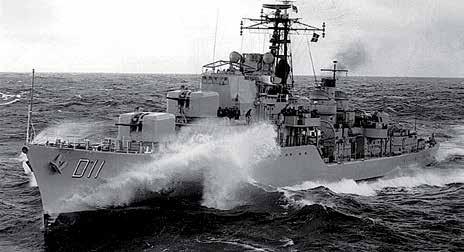
where you controlled the gun turrets. My job was up there, putting the guns at the right angle is the best way to explain it. Some people say that the shelling we did in Borneo wasn’t action as such, but it was an offensive role, because you’d go in there and you’d destroy something of the enemy’s.
During that period on Vampire we did three runs to Vietnam escorting the aircraft carrier HMAS Sydney, which was transporting troops and materiel for the Vietnam War. We would anchor in Da Nang Harbour for two or three days, as long as Sydney was unloading or loading.
One of our interesting jobs there was the anti-swimmer patrol, where we had to protect the ship from Viet Cong who would come either as swimmers or in
Vampire in about 1965, before the mid-life refit that enclosed the bridge and removed torpedo tubes and depth-charge mortar. Australian War Memorial photograph
have to go up the other side against the tide again. This went on 24 hours a day, just going round and around and around. Apart from that, we were throwing something like a grenade into the water at random intervals every few minutes, so that if any swimmers were in the water, the concussion would disable them.
After Vampire I joined the Attack class patrol boat Assail in 1970. I loved it! There was a lot of sea time out of Darwin.
My experience as a guide on Vampire –since the museum’s earliest days – has been really good. I’ve had no complaints. What I enjoy most is talking to people.
During that period on Vampire we did three runs to Vietnam escorting the aircraft carrier HMAS Sydney
sampans to lay mines. What they used to do was go across the bow of a ship with a dragnet and a mine. When they felt the dragnet grab the anchor cable, they’d let it go and the tide would swing the mine around underneath the anchored ship and it would blow up, which happened several times to American ships in that harbour.
Our Daring class destroyers carried two 25-foot motor-cutters, which on a calm day in a favouring wind would probably do nine knots, flat strap, dragging a lot of hooks and barbed wire and stuff behind to pick up any underwater swimmers or other threats. The tide in Da Nang Harbour runs at about seven knots, so it would take forever to get up the length of one side of the ship, and then you would turn around the bow, and be back down at the stern in no time at all! Then you’d
You do get quite a variety of people from all over the world who just want to have a look, and see what it’s like. I talk about how we actually lived in the ship, what we had to put up with. The questions that people tend to ask are very rarely technical, but more in line of ‘What happened here?’ or ‘What were the meals like?’.
What impresses visitors most about the ship is how small it is, and how you could live in there! If you get a good group, you can tell by their faces that they’re interested, and they like to listen to what you’re saying. I don’t usually talk about the Voyager disaster. It depends on the group. You get an impression about what the group are like reasonably quickly, and you can tell how far you can go with what you can say to them.
Page 39 SIGNALS 87 June–August 2009
The Mermaid report card

In January a team led by ANMM’s maritime archaeologist located the wreck of HMCS Mermaid, lost on the Great Barrier Reef in 1829. With them were two Bega High School students, winners of a national competition to join the expedition. Alice Lafferty and Megan Blacker write about the exhilaration of discovery!
The March 2009 edition of Signals reported in detail the story of Mermaid, an historic Australian vessel used by explorer Phillip Parker King to chart key sections of the Australian coast. In January 2009 staff of this museum led the ambitious expedition that found its resting place, after careful research to narrow down the location. The well-equipped expedition, generously funded by John Mullens Silentworld Foundation, provided a place for two high-school students and their teacher to participate in this important history project. The girls’ story follows.
IT WAS TUESDAY 2 December 2008 when we found out that we had won the competition to join the Mermaid expedition. To say we were excited is a gross understatement – ecstatic comes closer! Both of us literally jumped for joy on discovering that we had been chosen to spend a week on board a dive-boat. It was an amazing prospect to think that we would, for the first time, be snorkelling on the Great Barrier Reef and working with professional maritime archaeologists and historians. We soon found out just how fortunate we were and how utterly fantastic our prize was – and still is.
On 1 January 2009 we boarded a plane in Merimbula with our teacher, Ms Elaine Cozens. In Cairns we joined the Spoilsport, a professional diving vessel chartered by expedition sponsor Silentworld Foundation, to take us out to Flora Reef, the most likely position of the wreck. Spoilsport has three levels: below deck where the cabins are (we shared one and managed to fill it to the brim with our stuff!); the main deck with living-room, kitchen, and dining area (featuring two enormous flat-screen TVs for evening presentations); and a viewing deck upstairs with a glorious reef view.
Our first snorkel on the reef was stunning. We sighted numerous bright blue starfish that looked as though they were made of velveteen, and sea cucumbers – big black knobbly ones as well as skinnier grey ones. We also spotted an eel hiding in a hole: it was so cute and shy. And the coral – wow! All the bright little polyps that suck in and out and the tessellating patterns of the hard corals were just amazing. It was absolutely breathtaking to dive down into a world yet unseen by our eyes, and to discover all this beauty. And the fish! So many little fish and so many different types. It was magnificent. Each day staff and volunteers, spaced out along a rope swim-line, scanned the reef as they swam over it, with a waterproof
SIGNALS 87 June–August 2009 Page 40
GPS attached to either end to keep track of the ground we had covered. We were looking for things that seemed out of place, such as unnatural shapes and colours that could have been caused by corrosion – green for copper or red for iron. Soon we had found three pieces of metal: a viewing port from a compass about 10 cm in diameter, a compass swivel [gimbal] and a small bilge pump. Initially we thought they belonged to the Mermaid, but we soon discovered that they had been made later. It seemed that there was another wreck on this reef from a later date, which was making our search more difficult. Still, excitement and anticipation were building among the expeditioners!
It was so beautiful down there; there were fish everywhere, with colours and patterns from another world. Extensive sheaths of coral spread out below and giant clams about two metres in diameter were scattered on the sea floor. The fish dart around you inquisitively, and then teasingly swim away at the sight of the camera. So many colours – tiny blue fish, big parrot fish, purple, blue, green, red corals, in every shape or form you could imagine and even some you can’t. It was simply breathtaking and absolutely stunning!! We saw five turtles, a large shark, two smaller sharks, a stingray and some blue crayfish. We were finding it hard to keep up with the line because we would become distracted by something amazing, and then realise that we’d been left behind!
Each day another dive was made along a row of ‘hotspots’ – places where the magnetometer had picked up anomalies or ‘hits’ (indicating the presence of metal). The search team quickly found a location where a vessel had ploughed and essentially ‘bunny-hopped’ through the reef, discarding pieces as it went. We found more bits and pieces: two staples, some copper nails, a barrel ring

(or mast ring), another ring from a compass, and a pile of chain cemented to the reef floor. Unfortunately the weather worsened and we had to head back to Spoilsport, where we viewed some presentations on other shipwrecks and viewed the day’s photographs. When the weather cleared again we were able to participate in the work of tagging, where you take orange tags to either tie down or be weighted down to mark anything of significance. We both managed to find things to tag, including a solitary copper pin (which was part of the ship’s fittings).
That afternoon an anchor was found. This was an extremely significant find because it was one of the key things needed to establish whether this was the wreck we were looking for. Based on the position of the anchor in relation to the site [as recorded in the shipwreck survivors’ reports], the wreck was declared to be the Mermaid. Excitement spilled over and everyone was ecstatic! That night we celebrated!
As the discovery had been made public, the entire team was called up to the top
had been found earlier was being carefully cleaned when a broad arrow symbol (a government mark) was found on it – further proof that the wreck was indeed the Mermaid.
During our last night on board, we students were asked to do a combined presentation on what we had accomplished and our thoughts on the trip. Altogether we had snorkelled 11 km in seven days. Our dive leader Paul Hundley was impressed and so were we!
On our final day we went for one quick last snorkel. Afterwards we tried Manta boarding, where a line is towed behind the boat and you hold onto a plank of wood that allows you to go under the water and then come back up. We both had a fantastic time! Both Alice and Ms Lynch were interviewed about their experiences by phone. The national media had contacted expedition leader Kieran Hosty and then they wanted to talk to us! After that we farewelled our new friends and then left on the Pirate, a smaller boat that shuttled between the mainland and the research vessels. After our week afloat
It was absolutely breathtaking to dive down into another world and to discover all this beauty
deck to take some group publicity photos wearing our expedition caps and shirts. This was an electrifying and different experience! We then went and duck-dived onto the anchor so that we could get a feel for its significance. It was in about six metres of water. It was easily recognisable: a classic [Admiralty pattern] anchor.
As we resumed snorkelling along the line again, the current picked up and we were slowly swept to the side, meaning it took more time and effort to cover the same distance. It was a big slog against the current. This time nothing more was found. Meanwhile a pulley sheave that
we experienced ‘sea legs’ for the next couple of days (where you get the feeling you’re still moving) which was an extremely novel feeling for both of us!
We would like to thank Ms Lynch for taking us, John Mullens of Silentworld Foundation for his generous sponsorship, Kieran Hosty for his extensive work and organisation, and the entire crew for making us feel so welcome. It is most appreciated. We have both taken away many interesting perspectives. Alice plans to become an underwater scientific photographer and Megan plans to explore maritime archaeology as a future career path.
OPPOSITE: Megan Blacker, teacher Elaine Cozens and Alice Lafferty of Bega High School. RIGHT: Alice in the water. Expedition photographer Xanthe Rivett
Page 41 SIGNALS 87 June–August 2009

From revolution to reunion
There are 398 Hungarian names inscribed on the Welcome Wall. All of their life stories are interesting and some are profoundly moving. Wendy Wilkins meets one of our newest registrants, Gábor Attila Major.
GÁBOR MAJOR was 18 months old when he was separated from his parents Magda and Laszlo at the end of World War II. Caught in communist Hungary, he lived with his grandparents until 1956 when they were granted permission to leave. In 1957, aged 13, he was reunited with his parents and younger sister Veronika, all of whom had migrated to Australia in 1950.
Behind that brief statement of events lies a wealth of experiences, and Gábor Attila Major was generous in embroidering some of the bare facts in our telephone interview. He has the rich, gentle, calm and reassuring voice you would want in a rheumatologist, which is his profession. He lives and practises in Newcastle, New South Wales.
Gábor and his grandparents sailed on the Lloyd Triestino ship Neptunia. This was the first time Gábor had been at sea; in fact it was the first time he had ever actually seen the sea. Gábor said he had great expectations of the ocean. He read avidly as a small boy, especially books about the sea, and remembers with special fondness a book by Jules Verne (called The 15-year-old Captain in Hungarian, and Dick Sand: a Captain at Fifteen in the English version).
Gábor gives special mention to embarking at Naples, where he remembers so well the sights and sounds. ‘Everything smells different’ he says. Like many earlier northern European voyagers he recalls it as a kind of delicious assault on the senses. And the food was so different from Hungarian food. Coca Cola and Coke advertising did not exist in communist Hungary –a repressive regime in 1956 – and this was another revelation. He recalls seeing and eating an orange and a banana for the first time – an indelible memory. The Neptunia stopped at Messina in Italy, and he was struck by his first sight of palm trees! This was a strange, brave, exciting new world. However, while Gábor held romantic expectations about seafaring, and on the Mediterranean the voyage was calm, once the ship passed Gibraltar and entered the Atlantic they
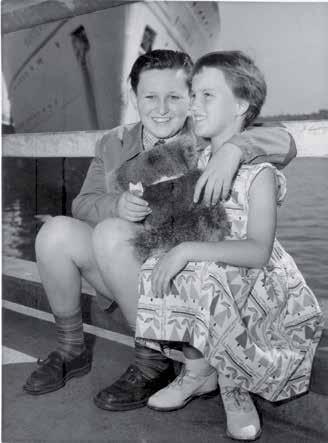
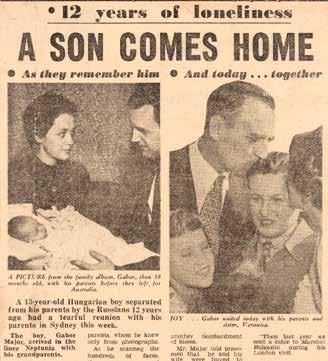
SIGNALS 87 June–August 2009 Page 42
TOP: Gábor Major, 13, reunited with his sister Veronika on the day he arrived in Australia. Photograph reproduced courtesy of Australian Consolidated Press. RIGHT: In the news … Gábor’s emotional arrival was covered in one of Sir Frank Packer’s newspapers.
The museum’s tribute to migrants, The Welcome Wall, encourages people to recall and record their stories of coming to live in Australia.

Two views of Neptunia from our collection: postcard published by Edizioni Pubblicità, artist unknown, 1950s; We are in the Seastorm of the Indian Ocean, oil on wood painting (2003) by Gina Sinozich. The painting is one of a series in our collection documenting the artist’s voyage of migration on Neptunia in 1957, when she, like Gábor on the ship’s next voyage, also suffered seasickness.
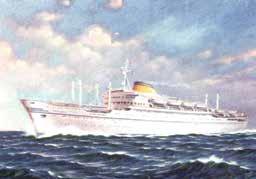
hit very rough seas and the enduring misery of seasickness meant that Gábor (and many others) lost interest forever in a life on the ocean waves.
The ship eventually stopped at Fremantle, then Melbourne, and then Sydney, where he was reunited with his parents and sisters after such a very long time. Did he have many expectations or images of Sydney? Perhaps not, but he has never forgotten that they sailed into the harbour in the early morning and it was breathtaking. To the 13-year-old, too, Luna Park was amazing. It’s still amazing, Gábor says.
There were not too many difficulties settling in, because his parents were already well established in Homebush. However Gábor, having no English, found his introduction to school difficult. At his school – St Patrick’s at Strathfield – he was the only boy with no English, and in those days there were no special classes for new arrivals. Maths was where he was able to make his mark, though, and by the end of his first year he had enough English to sit the exams.

He has the very clear recollection that even in a very small town, ‘we were infinitely caught up in it’. There were soldiers and tanks all over the place and while the kids had not the temerity to take them on, they did their best. Although school was closed, the students wrote pamphlets in Russian addressed to the soldiers asking whether they realised what they were doing. ‘We tried to do our bit’, Gábor said, with sadness and pride in his voice. There was a tremendous feeling of commonality – food was shared, for example – of all working together to achieve freedom. ‘It was the spirit of the whole thing.’
He describes it all so well. It was a bleak autumn, all grey rain – ‘Hungary is not attractive at this time of year’. There was hope, and no hope. Gábor’s primary happiness was to be leaving to join his parents and sister, and that was the joy above all.
Once the ship passed Gibraltar and entered the Atlantic they hit very rough seas and the enduring misery of seasickness
The Christian Brothers were very kind and helpful, Gábor says. There was one particular brother who out of kindness suggested that instead of Gábor, ‘let’s call you Jim’. Gábor resisted the offer.
Gábor was a child when he left Hungary, so while he remembers vividly some of the scenes of his homeland, he cannot really say he misses too many things. Well, yes, perhaps – the distinctive music and cuisine of Hungary. Our conversation returned to past happenings in Hungary. Gábor, his Australian-born wife and two children returned in 1990, when the Iron Curtain was being raised. It was lifted first in Hungary, and on the day the Majors arrived the last Russian troops left. There was an immense optimism in the air, Gábor observs.
Gábor had in fact left with his grandparents in 1956, the year of the Hungarian Revolution. ‘It was a very emotional time for me’, he said. He was caught up in the whole movement and he was proud of the people’s bravery. While they were not in Budapest but in a small country town, the movement and feelings were widespread. Kids his age were acting against the Soviet army and it was a nation able and willing to fight for freedom.
But he still felt that in some way he was abandoning the cause. But then: ‘Spring in Sydney, that harbour, the beautiful morning, that Luna Park. It was uplifting.’
There were some stories in the Sydney press when Gábor and his grandparents arrived. People like them were of interest; here was a people who had stood up to the oppressive world superpower that the Soviet Union was at the time.
‘We appreciated the warmth we received. This was a little different from the reception of migrants after the Second World War’, Gábor observes. ‘We felt very welcomed,’ was his last comment in the interview, spoken quietly.
It costs just $105 to register a name and honour your family’s arrival in this great country! We’d love to add your family’s name to The Welcome Wall, cast in bronze, and your story to the online database at www.anmm.gov.au/ww. So please don’t hesitate to call our staff during business hours with any enquiries regarding the project on 02 9298 3667.
Page 43 SIGNALS 87 June–August 2009
The tradesman’s entrance no more OFF-WATCH READING
A History of Sydney’s Darling Harbour by Wayne Johnson and Roger Parris, Sydney Harbour Foreshore Authority, 2008. ISBN 978-0-9805453-2-6, 144 pp, maps, b/w, colour plates, bibliography, index. RRP $59.95
SO YOU SIT at Yots café here at the museum, looking out over the water, and you contemplate the traffic on Darling Harbour. It’s quite busy: the familiar yellow Sydney Ferry goes past this way and that every half hour and there are the private ferries, the occasional yacht and workboat and even some busy little water taxis buzzing around. On the other side of the water, just a couple of hundred metres away, there’s the aquarium and a long row of restaurants with people – probably tourists – wandering in a relaxed fashion soaking up the sights and the sunshine.
And as you’re sitting there, looking across to the towering glass-and-steel western wall of the CBD, it’s virtually impossible to imagine the same scene a century ago – the lowrise city skyline, the waterway crammed with finger wharves, ships manoeuvring in and out, a forest of cranes in action and people everywhere unloading, loading, some bent under their burdens, some calling out and others just recuperating.
What was it all about? Where has it all gone? This new book unlocks a lot of information about this narrow basin that served so long as the tradesman’s entrance to the burgeoning city of Sydney until, in the 1980s, it went through a complete metamorphosis.
Authors Johnson and Parris are well equipped to relate this narrative, in fast-moving style. They share wide experience in industrial archaeology, heritage conservation, education and even the assembly of museum exhibitions. Systematically, they start at the beginning and carefully put down overlays of industrial and social development in chronological sequence. Their technique is to describe only the key events and issues, drawing timelines to condense the action. They present a great selection of paintings, prints and photographs to illustrate graphically what was going on.
So they lead us quietly into this Cadigal basin and sketch the earliest European developments – John Leighton’s three windmills on Miller’s Point (1810), Charles Griffin’s shipbuilding activity in Cockle Bay (1811) and Governor Lachlan Macquarie’s Market Wharf (1811) that catered for the increasing number of boats bringing produce downstream from Kissing Point (Ryde) and the Hawkesbury. Macquarie’s wharf, they contend, was particularly significant, providing access to the town markets on what is now the QVB site, and moving the town centre away from The Rocks. With the opening of this back door, Sydney’s long-term town plan was in place.
The account moves effortlessly through Darling Harbour’s development as New South Wales’ industrial hub with foodprocessing and food-exporting facilities, ship-building yards and a myriad of wharves along its eastern shore to accommodate
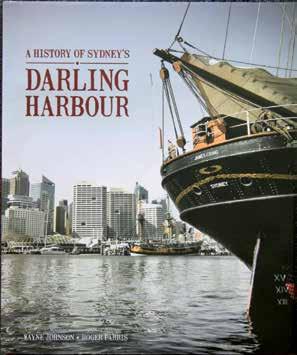
every imaginable type of vessel. The story gains further momentum with the development of the railway system in the 19th and early 20th centuries. Vast bulk stores and sheds were thrown up to accommodate the loads of timber, wool, wheat, coal and shale arriving by rail from across NSW to be shipped from this narrow waterway. The goods yards, mostly on the western side of the water (including the future ANMM site) were increasingly criss-crossed with railway lines and shunting trains. By the 1960s 22 ha of yards and 50 km of track handled 13,500 trains a year.
Change, when it came, was swift. Congestion at Pyrmont forced wool storage out to Yagoona. With containerisation, general cargo handling moved to Port Botany and elsewhere. The last goods trains trundled out of Darling Harbour in 1984. By then the plans were already set for a clearing of the harbourside lands for a new recreational precinct, opening to celebrate Australia’s Bicentenary in 1988.
Interestingly for us, as we sit at Yots café, the authors, with their archaeologists’ instincts, reveal that the last remaining part of Governor Macquarie’s Market Wharf is still in place, hidden away under Sydney Aquarium directly opposite us. Somehow this holds the whole story together. It all really happened.
FOOTNOTE: Don’t judge this handsomely designed book by its cover, on which Sydney Heritage Fleet’s tall ship James Craig and our own HMB Endeavour replica are shown in colour against modern Darling Harbour in muted shades of grey. Neither ship (nor the organisations that own them) are identified in a caption or anywhere else in the book.
Bill Richards, media and communications manager
SIGNALS 87 June–August 2009 Page 44
The Darings in detail Drawn to Darwin

Daring Class Destroyers
by Neil McCart, Maritime Books, Cornwall UK 2008. ISBN 978-1904459330, Hardback 240 pp; 115 b/w photographs. RRP £25
HAVE YOU ever wondered about Vampire’s sister ships? Not just the Daring class destroyers of the Royal Australian Navy but the eight that paved the way in the Royal Navy? If you have, then this is the book for you. Everything you ever wanted to know about the Daring class destroyer, and maybe some things you didn’t.
Neil McCart certainly has the credentials to write this book – 11 years service in the Royal Navy plus authoring some 30 books on British passenger liners and Royal Navy warships. And he has a good format – an amply illustrated hardback book that takes you through the entire career of each ship.
In this work on the Darings – ‘the class which epitomized the 1950s and 1960s’ – we have ‘the story of each of these ships from their beginnings in the late 1940s to their demise’. The chapters are comprehensive in their accounts of each RN and RAN ship – HM Ships Daring, Diamond, Duchess, Defender, Dainty, Decoy, Delight and Diana and HMA Ships Voyager, Vendetta, Vampire and Duchess. Note that Duchess – which replaced HMAS Voyager after the disastrous event of February 1964 – receives two chapters in order to accurately reflect the ship’s history in two navies.
The history of each ship is relived from the laying of the first keel plates to final operational duties, decommissioning and demise. In between is a detailed account of machinery trials and running exercises, deployments and manoeuvres, maintenance and refits, fleet exercises and tours of duty, accidents and disasters. The information is comprehensive but times and dates roll in front of your eyes after a while. McCart has scoured each and every relevant ship’s log, reports of proceedings, court martial records and reports of boards of inquiry.
What’s particularly nice about this book is that it includes the Australian Darings and the fact that HMAS Vampire is the last of all of the Darings – ‘a popular tourist attraction for Australians and foreign visitors alike, as well as former members of her ship’s company’.
My recommendation? If you are interested in naval history and you like facts and figures, this is the perfect book for you. Each chapter takes you on a journey across the seas, back to port and out again, never staying too long in one place, always alert.
Lindsey Shaw, senior curator maritime technology, exploration & naval history
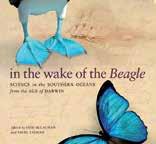
In the wake of the Beagle – science in the southern oceans from the age of Darwin, edited by Iain McCalman and Nigel Erskine. Published by UNSW Press in association with the Australian National Maritime Museum, 2009. ISBN 978 I 921410 94 9, soft cover, 192 pp; colour illustrations, footnotes, index. RRP $49.95 ($39.95 during exhibition).
This handsome and beautifully illustrated volume, the proceedings of the conference held in conjunction with our Darwin anniversary exhibition, was produced with the assistance of an Australian Research Council linkage project. The following review by Ian Fraser was broadcast on his natural history program on radio ABC 666.
I AM INTRIGUED by the history of Australian biology and have read widely on the subject, but this book told me a lot that I hadn’t come across earlier and did so most enjoyably.
The chapter on the day-to-day physical and mental problems of a naturalist living on a usually tiny, cramped, wet vessel is illuminating. As young men, some of the giants of British 19th-century biology – Charles Darwin, Thomas Huxley and Joseph Hooker – spent years on such ships, including in Australian waters. Darwin suffered terribly from seasickness, Huxley from what sounds a lot like clinical depression, but all recognised the enormous opportunities afforded them – and the experience shaped their long and glorious careers.
I had previously known little of Joseph Hooker’s time in Australia, two years before his father William became the immensely influential director of the Royal Botanical Gardens at Kew, a position that in time Joseph himself was also to fill. Further, I had never heard of the ill-fated John McGillivray who, but for chance and perhaps his own unfortunate manner, might have been just as famous; I am grateful for the chapter on him.
Other imaginative offerings include a three-chapter section on interactions with indigenous people, including essays on the experiences in New Guinea of the Rattlesnake, under Owen Stanley with Huxley on board, and on Alfred Wallace’s remarkable 1600-kilometre journey in a Malay prau [Wallace’s etymology for the Malay perahu], which contributed greatly to his own brilliant work on evolution and Wallace’s Line.
There is a fascinating chapter on the instruments available to 19th-century navigators and field biologists and another on the techniques available to their modern counterparts. And the illustrations, many from the National and Mitchell Library collections, and many of which I have never seen before, are a joy in themselves. A superb book at all levels.
Page 45
SIGNALS 87 June–August 2009
CURRENTS
Artist’s fame outstrips his subject
VISITORS to the Nowra Museum have long admired the handsome profile of the Shoalhaven’s first river pilot, Captain John Craig, but little did they realise that the painter was an important Australian historical figure.
With funding from an Australian National Maritime Museum maritime heritage grant, a recent restoration has revealed that the portrait was painted by notable artist and former owner of The Bulletin magazine William McLeod Anderson. McLeod, who established his name as an artist on The Bulletin in the early 1880s, went on to become manager and managing director of magazine from 1887 to 1927. Most famously, he had The Bulletin founder and editor J F Archibald committed to Callan Park Lunatic Asylum in February 1908, a betrayal for which Archibald never forgave him. McLeod also published Joseph Furphy’s classic Australian novel Such is Life and by the time of his death in 1929 his estate was valued at £232,000.
The Shoalhaven Historical Society only discovered his name when the painting was
removed from its frame. The painting is thought to have been painted in the 1870s when McLeod was still an unknown young artist. His subject was the highly respected seaman Captain John Craig. Craig had migrated from England in 1854 with little to his name, but rose under the guidance of the Shoalhaven settler Alexander Berry. Craig started his career in command of Berry’s boats, and was later placed in charge of all shipping and customs that moved between Sydney and Melbourne.
‘The painting is a vital link in the maritime heritage of the Shoalhaven,’ said Shoalhaven Historical Society President Lynne Allen. ‘It links Berry, the coastal and passenger maritime trade and the iconic Bulletin magazine.’
The $4090 cost of the restoration was funded by the Maritime Museums of Australia Project Support Scheme (MMAPPS), the annual maritime heritage grant scheme administered by this museum and funded jointly by us and the Australian Government
Introducing Deckster!
OUR CHILDREN’S programs team would like to introduce Deckster, the ship’s cat who will be the mascot for the Kids on Deck children’s programs at the museum. A competition to name our cat was held over the April 2009 school holidays and we had some very considered and creative suggestions put forward. After much deliberation over the wonderful entries submitted, the team selected the name Deckster suggested by Eva, aged 8, from Green Valley, ‘because he is the star of the deck’, as she told us. Eva won a prize bag of goodies
from The Store and an all-attractions family pass to the museum. We will be using Deckster the cat in our marketing programs and within the museum in the form of banners and directional signage, so that families can immediately identify, find out about and locate our popular programs for children. Some of our current Kids On Deck activities include the Mini Mariners program for under-fives on Tuesdays during term and Discover Mr Darwin on Sundays and school holidays. See pages 26–27 for more details.

through the Distributed National Collections Program of the Department of the Environment, Water, Heritage and the Arts. The conservation of the painting and frame has improved the perspective of the painting.
‘Captain Craig is looking most handsome,’ said the conservator, Kathy Lillico-Thompson. ‘After the cleaning there is more definition in the dark areas. His face is much more luminous and you can see how beautifully painted it is, especially the eyes.’
SIGNALS 87 June–August 2009 Page 46
Conservator Kathy Lillico-Thompson works on the portrait of Captain John Craig. Photographer A Frolows/ANMM
SPONSORS
Leave a gift in your will
LEAVING A GIFT to the Australian National Maritime Museum in your will is a thoughtful way to benefit the community, showing forethought, planning and commitment.
People from all walks of life leave gifts both large and small to museums and galleries, recognising the role such institutions play in our lives. It can be a way to make the type of gift that you may not be able to make during your lifetime.
Your bequest (or gift) can take many forms including cash or securities, real estate, life insurance policies, life income plans, annuities or trusts, cultural property such as books and maps or maritime related works of art. A bequest can be used for many things including developing and managing the National Maritime Collection; research, acquisition, conservation, interpretation, scholarship, publication outreach and education; or fostering traditional maritime skills and practices.
Unrestricted bequests can also be made without a designated purpose so that they assist with the museum’s priorities at the time. This allows greater flexibility to meet sometimes unpredictable future needs. The museum will follow the wishes of the person making a bequest wherever possible. With bequests of objects and artworks, we have to check the condition of the object before accepting it into the collection.
There are a number of different types of bequest. An outright bequest is an unconditional gift of cash, financial instrument, real or any other form of property.
A residuary bequest provides for the museum to receive the remainder of your estate after all other bequests have been granted. In a contingent bequest, you stipulate that the museum will receive the bequest only if your other named beneficiaries (usually family members) die before you.
An endowment bequest uses endowment funds to ensure the permanence of your gift. These are managed in a way that protects the original value of the capital against inflation. Your original gift stays intact and only the annual income is used. It’s an excellent way to help build the future while creating a lasting tribute in your name or in memory of someone special to you.
Whatever your bequest, you will have left a legacy of quality for those who live after you. As each individual’s financial and family situations are unique, please discuss all options with your solicitor, accountant or other financial adviser to determine the best one for your situation.
If you make a bequest in your will to the Australian National Maritime Museum, do let us know about it. We can then keep you up to date with information and developments at the museum and invite you to relevant special events throughout the year that we hold for our benefactors. All information received by the museum is treated in the strictest confidence and we will respect your wishes if you choose to remain anonymous.
To discuss leaving a bequest, please contact us on 9298 3777 or send an email to us at sponsorship@anmm.gov.au.
Corporate Members of the museum
The program provides corporate Members privileged entry to the museum’s unique environment for corporate hospitality.
Three membership levels each provide a range of benfits and services:
Admiral (three-year membership $10,000; Commodore (three-year membership $5,000);
Captain (three-year membership $1,800).
Admiral Memberships
Ferris Skrzynski & Associates Pty Ltd
Commodore Memberships
Captain Memberships
Art Exhibitions Australia Ltd
Asiaworld Shipping Services Pty Ltd
Australia Japan Cable Ltd
DN SDC-RPA
HMAS Creswell
HMAS Kuttabul
HMAS Newcastle
HMAS Penguin Welfare Committee
HMAS Vampire Association
HMAS Watson Ships Fund
Maritime Workers Credit Union
Maritime Union of Australia (NSW Branch)
Maruschka Loupis & Associates
Penrith Returned Services League
Pivod Technologies Pty Ltd
Regimental Traust fund, Victoria Barracks
Royal Caribbean & Celebrity Cruises
Svitzer Australasia
Sydney Pilot Service Pty Ltd
Museum
sponsors
Principal sponsors
ANZ
Australian Customs Service
State Forest of NSW
Major sponsors
Blackmores Ltd
Lloyd’s Register of Shipping
Raytheon Australia Pty Ltd
Tenix Pty Ltd
Sponsors
Akzo Nobel
Australian Maritime Safety Authority
Abloy Security
Bill and Jean Lane
BT Australasia
Centenary of Federation
Institution of Engineers Australia
Louis Vuitton
Speedo Australia
Wallenius Wilhelmsen Logistics
Project sponsors
ABLOY Australia
Cathay Pacific Cargo
Coral Sea Wines
CSIRO
DMS
Forrest Training
Harbourside Darling Harbour
James Squire Beer
‘K’ Line
Lloyd’s Register Asia
MCS
Maritime Union of Australia
Mediterranean Shipping Company
Mercantile Mutual Holdings
Novotel Rockford
Philips Electronics Australia
SBS
Scandinavian Airlines
Shell Companies in Australia
Specific Freight
Sydney by Sail
Visions of Australia – Commonwealth Govt
Vincent Fairfax Family Foundation
Founding patrons
Alcatel Australia
ANL Limited
Ansett Airfreight
Bovis Lend Lease
BP Australia
Bruce & Joy Reid Foundation
Doyle’s Seafood Restaurant
Howard Smith Limited
James Hardie Industries
PG, TG & MG Kailis
National Australia Bank
P&O Nedlloyd
Telstra
Westpac Banking Corporation
Wallenius Wilhelmsen Logistics
Zim Shipping Australasia
Donors
Grant Pirrie Gallery
State Street Australia
Page 47 SIGNALS 87 June–August 2009
From the director
IN MARCH the Federal Minister for the Environment, Heritage and the Arts, the Hon Peter Garrett AM MP, announced my re-appointment as director of the Australian National Maritime Museum for a further five year term. Since I was first appointed director in 2000, I have taken immense pride and pleasure in having the opportunity to lead this museum, and to work with a truly dedicated team of staff and volunteers to make it the remarkable cultural institution that it is today.
There is much to remember about these eventful years. My tenure as director got off to a spectacular start when the museum was a focus of the Darling Harbour component of the Sydney 2000 Olympic Games. Since then there have been some memorable milestones, such as the arrival of the replica
Mary-Louise Williams
Minister Garrett also announced the appointment of another new Council member, Mrs Robyn Holt, for three years. Mrs Holt is the former chief executive of a number of local and European companies, most recently at Collette Dinnigan Pty Ltd, with extensive experience in publishing, fashion and beauty retail industries in Australia and internationally. We welcome her most warmly, and the new and valuable perspectives she brings to the museum’s governing body.
What really gives the most satisfaction is seeing the increased numbers of visitors
of James Cook’s HM Bark Endeavour when it came under the museum’s management in 2005. Another would have to be launching the Australian Register of Historic Vessels, a very important national heritage resource. There’s a story on page 18 showing how well the register is working for us and the community.
There has been a great deal of satisfaction in building strong working relations with museums and colleagues in other countries, and gaining access to their collections. This has resulted in some wonderful exhibitions travelling to us from overseas, such as the beautiful art works of Les Génies de la Mer – Masterpieces of French Naval sculpture But of all the achievements of these years, the thing that has really given the most satisfaction is seeing increased numbers of visitors reaching us, after we took the bold step of making entry to the museum free.
IT WAS REALLY with great reluctance that we have had to call off the HM Bark Endeavour replica’s planned voyage to several ports along the Queensland coast later this year. Bookings for the various voyage legs were well below expectations, and we reached the point where it became clear that we would be sailing into some severe losses that we can ill-afford at this time. It seems that the economic downturn has had a significant effect on people’s willingness or ability to spend on this sort of experience, as unique as an Endeavour voyage may be. Of course, it’s been the experience right across the travel industry that people are postponing or downgrading their plans.
To those whose voyage bookings we have had to refund, we extend our sincere apologies. It’s been disappointing for everyone, our crew included, particularly considering the success of our coastal voyages since the Endeavour replica came under our management. The ship and crew have set great standards in terms of providing a unique experience of 18th-century seamanship and ship-board life. We do remain fully committed to voyaging the ship to Australian ports and sharing the experience as widely as possible. In the meantime we are looking at developing a program of shorter voyages better suited to the present financial situation.
WE WERE ALL tremendously pleased, at the Museums Australia 2009 Conference held in Newcastle in May, when the winners of the Multimedia and Publication Design Awards were announced, and we were up there on the podium. Our two winning entries (pictured at left) were the invitation to the opening of our very popular 2007–2008 exhibition Bateaux Jouets – Toy boats from Paris 1850–1950, and another promotional postcard that we produced for marketing the show. Congratulations to our staff graphic designer Heidi Riederer, whose design of the Bateaux Jouets identity was very skilful and gave it a joyful and distinctive quality.

Die-cut invitation and promotional postcard for a recent exhibition were the winners of their respective sections in the Museums Australia publication design awards announced at the Museums Australia 2009 Conference held in Newcastle in May. They are the work of staff graphic designer Heidi Riederer. Photographer J Mellefont/ANMM
SIGNALS 87 June–August 2009 Page 48
Click on Shop
Hundreds of books … something for everyone … from key rings to shipmodels and boating clothes … friendly service … mail order … Members discounts!
Open 9.30 am to 5.00 pm seven days a week
Phone 02 9298 3698 or fax orders to 02 9298 3675 or email mlee@anmm.gov.au








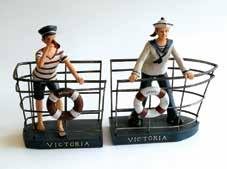



shopping
available safely
securely
annm.gov.au
Online
now
and
at
Rediscover your world with small cradle globe $99.95 Members $89.95 Check, mate! Russian navy chess set $120.00 Members $108.00 Great White Fleet can cooler $10, tile $22, mug $15 (Members $9, $19.80,$13.50) The evolutionary Charles Darwin soft doll $45.00 Members $40.50 Globe and globe money box (17 cm) Globe $75.00 Members $67.50 Money box $60.00 Members $54.00
scrimshaw tobacco jar $29.95 Members $26.95 Australian clipper jewellery box $55.00 Members $49.50 Boxed brass sextant, 5˝, the perfect corporate gift $99.95 Members $89.95 Bird plaque 32x32x5.5cm, 3 designs available. Normally $80.00 special price $30.00 Wooden folk-art money box (pirate or mermaid) $20.00 Members $18.00 Brave sailor bookends for youir nautical bookshelf Normally $60.00, half-price special $30.00
the flag with White Ensign cuff link, tie clip set $49.95 Members $44.95 Monogrammed ANMM leather document satchel $99.95 SPECIAL OFFER Members $60.00
Replica
Fly
The
museum
Open daily except Christmas Day
9.30 am to 5.00 pm (January to 6.00 pm)
Darling Harbour, Sydney NSW Australia
Phone 02 9298 3777 Facsimile 02 9298 3780
ANMM council
Chairman
Mr Peter Sinclair am csc
Director
Ms Mary-Louise Williams Councillors
Cdre Stephen Gilmore am csc ran
Mr Peter Harvie
Ms Robyn Holt
Dr Julia Horne
Emeritus Professor John Penrose
Mr John Rothwell ao
Mr Neville Stevens ao
Signals ISSN 1033-4688
Editorial production
Editor Jeffrey Mellefont 02 9298 3647
Assistant editor Penny Crino
Photography
Staff photographer Andrew Frolows
Design & production
Jeremy Austen and Jo Kaupe, Austen Kaupe Printer
Printed in Australia by GEON group
Advertising enquiries
Jeffrey Mellefont 02 9298 3647
Deadline end of January, April, July, October for issues March, June, September, December
Signals back issues
The museum sells a selection of back issues of Signals. Back issues $4.00, 10 back issues $30.00.
Extra copies of current issue $4.95. Call Matt Lee at The Store 02 9298 3698
Material from Signals may be reproduced only with the editor’s permission 02 9298 3647.
The Australian National Maritime Museum is a statutory authority of the Australian Government. For more information contact us at:
GPO Box 5131 Sydney NSW 2001 Australia ANMM on
web www.anmm.gov.au
the






























 OPPOSITE: Figure 1: Swimwear created as a special commission for the exhibition by designers (LEFT TO RIGHT) Tigerlily, Anna & Boy, Zimmermann and Jets Black Label. The suits were donated for the museum collection.
OPPOSITE: Figure 1: Swimwear created as a special commission for the exhibition by designers (LEFT TO RIGHT) Tigerlily, Anna & Boy, Zimmermann and Jets Black Label. The suits were donated for the museum collection.






































































